










RÓISÍN ANNESLEY KC
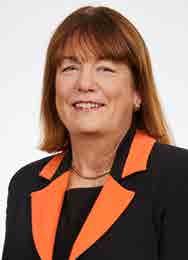
Flexibility was the buzz word which defined 2021/2022. Barristers were asked to be flexible as to:
› the manner of trial/hearing;
› the giving of evidence remotely;
› the location/conduct of a mediation;
› the manner of the delivery of briefs;
› presence in chambers.
Flexibility was demanded/required/sought, in varying degrees, by courts, barristers, solicitors and clients.
Flexibility is fine. Indeed, the Victorian Bar has shown a great willingness and ability to change and compromise. Flexibility, however, needs to have boundaries. We cannot bend so far that we break – either as a college or in respect of our duties to the court and the client. The duty to the court is paramount; the obligation to the client is superior to ours or the court’s convenience.
Bar Council has worked hard throughout 2021/2022. It focused on:
› sensible financial management and use of members’ subscriptions;
› minimising spending so as to reduce subscriptions;
› ensuring the delivery of a comprehensive CPD program;
› the delivery of two excellent in-person Readers’ courses;
› promoting a healthy, respectful workplace for everyone;
› initiating the largest IT project in 40 years to service barristers, clients and the Bar Office.
Through sensible financial management and with an eye to minimising expenses without reducing services, subscriptions were reduced for almost all members by five per cent. I acknowledge and thank the Bar’s Manager, Finance and Membership, Mark Bryant for his careful work and prudent advice. I also thank the Hon. Treasurer Mark Robins KC, the Assistant Hon. Treasurer Robyn Sweet and the members of the Audit, Risk and Finance Committee: David Gilbertson KC, Michael Flynn KC, Benjamin Murphy, Dean Luxton, Edward (Eddy) Gisonda, Jane Sharp, Justin Mereine, Andrew Burnett and Lana Collaris for their significant contribution to the Bar this year.
The Bar has been greatly assisted by Barristers’ Chambers Limited (BCL) and the Barristers’ Benevolent Fund in 2021/2022. On behalf of the Bar, I extend my thanks to the Hon. John Digby KC, Chair of the BCL Board and to Mr Paul Clark, CEO of BCL for their continued and considerable support of Victorian barristers during COVID-19 and the Bar more generally.
The Barristers Benevolent Fund (BBF) has also extended support to those barristers and their families who were in need of financial assistance during 2021/2022, and I thank the Board of the BBF for their careful consideration of the applications which came before them and the

consideration given by Finkelstein KC to this difficult issue and wish the 2023 Bar Council all the best in its endeavours to solve the problem.
This past year has seen the implementation of our Victorian Bar’s Peer Support Barristers. Under the Bar’s Code of Conduct policies, Peer Support Barristers are the first point of contact for people with enquiries related to discrimination, sexual harassment or workplace bullying.
I thank the Peer Support Barristers: Lachlan Armstrong KC, Elizabeth Bennett SC, Dr Michelle Sharpe, Amanda Hurst, Jack Tracey, Jo Swiney, Sarah Keating, Kylie WestonScheuber, and Caitlin Dwyer.
More than 120 members underwent the Sexual Harassment Awareness Training organised by the Bar in 2022. In addition to the required pre-reading and informative sessions, members participated in sessions dealing with hypothetical scenarios. The feedback from the sessions was overwhelmingly positive.

management of the fund.
In 2021/2022 the Bar delivered 86 CPD sessions covering a vast array of topics in all areas of practice. The CPD program is an extraordinary service by barristers for barristers. Although it could be quantified in monetary terms, it is the willingness of barristers to share their knowledge and experience with their colleagues which makes the CPD programme invaluable. I extend a special thank you to Richard Dalton KC, Chair of the CPD Committee for his careful management of the programme and to the committee: Rachel Walsh, Deputy Chair, Darren Mort, Stephen Moloney, Peter Clarke, Romauld Andrew, Philip Hayes, Robert O’Neill, Zoe Maud, Andrew Meagher, Premala Thiagarajan, Lana Collaris and Deborah Siemensma. Thank you to the Bar Office staff, Michelle James, Golam Kibria and Nikki Walker for their assistance in the delivery of each of the 86 sessions.
This year 94 new Readers joined the Victorian Bar. It was particularly pleasing to have both courses for 2021/22 completed in person. The Bar Council was conscious of the workload imposed on the volunteers who teach in the Readers’ Courses. With that in mind, and with an eye to succession, the Bar Council sought to expand the pool of teachers for the Readers’ Courses. I wish to acknowledge the willingness of all barristers who volunteered their time to teach in the Readers’ Courses; I particularly acknowledge the enormous contribution of Andrew Palmer SC and Patrick Doyle SC who tirelessly dedicate themselves during advocacy week to the course. Thank you to Justin Graham KC and the Readers’ Course committee for their continued dedication to the Readers’ Course. Thank you to Michelle James and Nikki Walker who managed the courses with such care and efficiency.
In 2022 the Bar Council commissioned Ray Finkelstein AO KC to consider the perennial ‘Overhang issue’ of the waiting list for the Readers’ Course. I am grateful for the careful
This year saw the launch of the referral scheme for pro bono assistance to help unrepresented litigants involved in Family Law proceedings. It was a joint initiative of the Federal Circuit and Family Court of Australia and the Victorian Bar. I extend my thanks to the Hon. Chief Justice William Alstergren AO and to Meredith Schilling, Don Farrands KC, Leslie Glick KC and Nicholas Kanarev who have been instrumental in the introduction of the scheme.
For a variety of reasons, the life of the Bar’s current IT infrastructure is expiring rapidly. The Bar Council, assisted by the IT Steering Committee, chaired by Michael Shand AM KC, undertook a comprehensive review of the existing IT Infrastructure and the Bar’s future needs and the services available in the market to service those needs. The Bar is indebted to Michael Shand AM KC, Amanda Utt, Daniel Calleja, David Sanders, Miranda Tulloch and the IT Project Manager Paul Francis for the enormous work done on this complex but vital project for the Bar.
This year saw the return of more social functions at the Bar. The Essoign Club re-opened for breakfast, lunch, coffee and drinks. The Bar hosted many social events including Meet the Coroner, Readers’ dinners, Junior Bar Conference, History of the Victorian Bar Book launch, Victorian Bar Foundation Student Achievement Awards, 2022 Asian Australian Lawyers Association William Ah Ket Scholarship launch, the Iftar Dinner and a farewell dinner for the Honourable Geoffrey Nettle AC KC.
A number of new portraits were hung and unveiled in the Peter O’Callaghan QC Gallery including those of Brian Shaw QC, Richard Stanley QC, Ron Merkel KC, Julian Burnside AO KC, William Ah Ket and Brendan Murphy KC. I thank Siobhan Ryan KC, Chair of the Arts & Collections Committee for her tireless work.
This year’s Bar Dinner was a wonderful celebration of the achievements of so many members, with particular focus on those members who have been in continuous practice at the Bar for 45 years. The Bar was particularly honoured by the presence of Her Excellency the Honourable Linda Dessau AC, Governor of Victoria and Mr Anthony Howard KC. We were treated to entertaining and insightful speeches by the Hon. Justice Alstergren AO, Chief Justice of the Federal Circuit and Family Court of Australia and the Hon. Jaclyn Symes MP, Attorney-General for the State of Victoria. The Bar was delighted to host Justices Gordon and Steward of the High Court of Australia, Chief Justice the Hon. Ferguson, the Hon. Justice Quigley; Chief Judge Kidd and Chief Magistrate Hannan, together with 80 other honoured guests. The 520 members in attendance enjoyed the opportunity to catch up with friends and colleagues.
The Australian Bar Association Conference Re-Emerge was held in April. The Victorian Bar was pleased to work alongside the ABA in hosting a number of sectional dinners. I thank all those who work hard to make those dinners successful. Dr Matt Collins AM KC, Paul Hayes KC, Sam Hay KC and Raini Zambelli are to be congratulated on their hard work organising the conference.
It was a privilege to represent the Bar at the judicial welcomes and farewells throughout 2021/2022. We had a record number of judicial welcomes (28), together with four judicial farewells. Notably the Hon. Christopher Maxwell KC retired as President of the Victorian Court of Appeal and the Hon. Justice Karin Emerton was appointed in his stead. I wish them both well in their respective endeavours. I congratulate all members of the Bar who have been appointed to the Bench in 2021/2022.
On behalf of the Bar I thank all members who so generously gave their time to contribute to Bar committees, associations, education programs and other Bar activities across the past year.
On behalf of the Bar, I acknowledge and thank the Bar Office staff for their commitment to and hard work for the Bar. Denise Bennett, assistant to the President retired after 17 years of service. Denise was not only the holder of a wealth of corporate knowledge, she was always pleasant and helpful, an incredibly efficient and willing worker. On behalf of the Bar, I wish her all the best for her retirement.
Thank you to Amanda Utt, who has done an exemplary job as Executive Director. Amanda maintained a happy and cohesive team in the Bar Office, ensured that Bar Council had all the information and assistance it sought and was of tremendous assistance to me, in what was in many ways a challenging year.
I acknowledge the good work and dedication of Mark Bryant, Manager, Finance and Membership, Kai Li Zhu, Senior In-House Counsel, Miranda Tulloch, Corporate Services Lead, Roisin Ryan, Communications and Stakeholder Engagement Lead and Michelle James, Education Manager.
I thank all members of the Bar Council for their contribution to the good governance of the Bar this year. I particularly thank Vice Presidents Charles Shaw KC and Darryl Burnett, Mark Robins KC, Hon. Treasurer and Robyn Sweet, Assistant Hon. Treasurer for their dedicated service on the Executive of Bar Council.

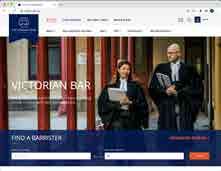

























Eight Meetings of the Victorian Bar Council were held between 1/7/21 and 11/11/21 (being the date of the last meeting of the 2020/21 Bar Council), including One Special Purpose Bar Council Meeting. Number
Christopher Blanden QC (President)
Róisín Annesley QC (Senior Vice-President)
Darryl Burnett (Junior Vice-President; elected on 19 August 2021)
Mary Anne Hartley QC (Honorary Treasurer)
Dr Ian Freckelton QC
Georgina Schoff QC
Dr Suzanne (Sue) McNicol AM QC
Wheelahan QC
Category B: Junior counsel who are





















Committee as at 30 June 2022: Natalie Sheridan-Smith (President), Arna Delle-Vergini (Vice-President), Christine Pollard (Honorary Treasurer), Michelle Jenkins (Co-Secretary), Beth Warnock (Co-Secretary), Amanda Wynne, Adrian Kennedy, Jordana Cohen, Karen Chibert and Tanya Kamil.
The Children’s Court Bar Association (CCBA) committee thanks Cilla Brookes (Secretary) who resigned from the Committee in February 2022.
On 9 December 2021, we held our AGM and, more importantly, our end-of-year function! Several past Presidents of the Children’s Court, as well as many members of the judiciary, attended as guests. This was the first opportunity to catch up with colleagues and friends in person for many months.
Thank you to all members of the CCBA committee for their hard work and significant contributions to our organisational priorities and achievements this year.
Special thanks to Jordana Cohen, our Children’s Court CPD working group representative. Jordana and Karen Chibert ran a complementary program specific to our CCBA members. Jordana was instrumental in delivering a quality CPD program to a broad audience across both organisations.
Significant efforts over many months have resulted in a strong, ongoing liaison with new leadership at the Department of Families, Fairness and Housing (DFFH)/Child Protection Litigation Office (CPLO). This has led to important concessions being made about the state of fees paid to members who appear for DFFH in the Children’s Court. Ultimately our determined advocacy led to a significant increase in preparation fees effective September 2022. The committee will continue to advocate for an across-the-board increase in FY2023.
Arna Delle-Vergini and Natalie Sheridan-Smith have partnered with DFFH/CPLO leadership to establish a new Working Group to improve professional relationships across all organisations within the Children’s Court and to ensure a more collaborative approach to litigation for the benefit of children and families.
Ongoing liaison with Victoria Legal Aid (VLA) and the Children’s Court President/executive continues.
The CCBA has also participated in several consultation forums related to new Guidelines for Judicial Conduct.
Jordana Cohen and Adrian Kennedy are our representatives on an important Multi-Bar Association Working Group that advocates for the age of criminal responsibility for children to be raised from 10 to 14 years.
Tanya Kamil and Beth Warnock are developing our VicBar/ CCBA website pages to add important resources to make the website more helpful for members.
Our financial position is favourable. A minor increase in our subscription fees brought us in line with other Bar Associations. We have also drafted new CCBA by-laws for endorsement at our next AGM.
Lastly, congratulations to CCBA member Lucy Raponi, recently appointed a Children’s Court Magistrate!
Committee as at 30 June 2022: Stewart Maiden KC (President), Paul Hayes KC (Senior Vice-President), Lisa Hannon KC (VicePresident Convenor), Sam Rosewarne (Treasurer), Veronica Holt (Honorary Secretary), Ella Zauner (Assistant Honorary Secretary), Oren Bigos KC, Meg O’Sullivan KC, Hamish Redd, Kylie WestonScheuber, Jesse Rudd, Emma Murphy, Raini Zambelli, Daniel Lorbeer (Honorary Member) and Scott Cromb (Honorary Member).
The Commercial Bar Association (CommBar) has almost 750 members, including several clerks.
This year, the CommBar executive has commenced a two-year project to re-focus the organisation and create a more efficient platform for future operations.
Executive members have been allocated portfolio responsibilities, and the hard-working communications officers have been co-opted as honorary executive members. Among the most significant initiatives is a review of CommBar’s constitutional structure and its 21 sections.
The results of those activities will not be realised until next year. However, major milestones achieved to date include:
› progressing investigations into incorporation,
› re-invigorating and re-launching the Energy and Infrastructure section,
› advancing the potential creation of three further sections, and
› launching a re-invigorated LinkedIn page.
An ongoing theme of CommBar’s work involves promoting relationships between its members and the wider profession, including solicitors, other barristers and judges. To that end, CommBar has continued its relationship with the Association of Corporate Counsel (ACC) through a co-sponsorship with the Victorian Bar, conducting three successful events with the ACC this year. CommBar also hosted a sold-out dinner, attended by many judges and interstate barristers, at the Australian Bar Association conference in April.
The Association continues its close involvement with the commercial courts.
This year it contributed to the Scale of Costs review undertaken by the Honourable Justice Jack Forrest and her Honour Judge Kathryn Kings; liaised with State courts
regarding the ongoing COVID-19 restrictions imposed on them; attended meetings with Supreme and Federal Court judges regarding diversity initiatives, and contributed to the development of the comprehensive new County Court Commercial Division Practice Note.
As usual, CommBar has contributed to various law reform issues this year. Most significantly, contributions to the Commercial Division Practice Note and a Commonwealth Treasury consultation regarding schemes of arrangement involved many members working to produce comprehensive submissions.
CommBar continues to focus on its educational offering, concentrating this year on consolidating that programme. The executive has also been in touch with courts and law schools in an endeavour to determine how best to involve the judiciary and the academia in our educational offering.
CommBar has again awarded the Alan Goldberg Bursary to one barrister in each Readers’ Course, bringing to seven the number of readers who have benefited from CommBar paying their examination and Readers’ Course fees.
CommBar is immersed in the production of its third offsite conference at the time of writing. The executive and membership are looking forward to The Long (Legal) Paddock: an offsite conference aimed at junior members to be held in Albury-Wodonga in November.
Thank you to the very many members of CommBar’s executive and membership who have contributed to the success of its activities this year. They know who they are, and they have our abiding thanks.
Committee as at 30 June 2022: James Mighell KC (Chair), Mary Anne Hartley KC (Treasurer), David Martin (Secretary), Lachlan Allan (Assistant Secretary), Tim Tobin SC, Andrew Clements KC, Róisín Annesley KC, Áine Magee KC, Michelle Britbart KC, Fiona Ellis, Patrick Over, Gavin Coldwell, Stephen Jurica, Michael Clarke, Julia Frederico, Raph Ajzensztat, Jessica Clark, Carmelina Spitaleri, Scott Davison, Tristan Nathanielsz and Peter Haddad.
During the year, the Common Law Bar Association (CLBA) has been involved in a number of activities including:
Representatives of the Common Law Bar Association have met regularly with judges of the Supreme and County Courts in relation to:
› facilitating the return of in-person work post COVID-19; and
› the conduct of common law trials in both courts and serious injury applications in the County Court.
In addition, the Association continues to be represented on the various user or stakeholder groups of the Supreme and County
Courts and provides updates to its members as required following meetings of these groups.
This past year, the Association has established:
› a Briefing Sub-Committee with the aim of assisting firms with the efficient preparation of streamlined briefs; and
› a Law Reform Sub-Committee which will investigate and report to the Committee on areas of potential law reform within the personal injuries sphere.
The Association has been assisted by submissions drawn by members of the CLBA in relation to the Supreme and County Courts’ Review of Litigious Costs.
The Association’s CPD Sub-committee continues to provide a comprehensive program of regular CPDs for members. This year the Sub-committee also held a “case update” CPD to which solicitors were also invited. This was well attended and received, and it is anticipated that it will become a regular event.
The Association has liaised with his Honour Judge Arushan Pillay to streamline the process by which its members assist the Court by providing pro bono legal representation in personal injury matters.
The Association continues to provide regular case summaries of recent Court decisions to its members.
The Association held its 2021 Annual Meeting and Dinner on 15 December 2021, both of which were very well attended.
The number of CLBA members continues to increase. Currently, 337 Victorian Bar members are members of the Common Law Bar Association.
Committee as at 30 June 2022: Megan Cameron (President), Ray Ternes (Treasurer), Kathy Karadimas (Secretary), Sascha Dawson, Kim Bradey, Lachlan Allan, Robert Paoletti, Oliver Lesage, Peter Haddad and Brendan Johnson.
In March 2022, Her Honour Judge Maria Tsikaris was appointed to the County Court of Victoria. Judge Tsikaris was a member of the Compensation Law Bar Association Committee at the time of her appointment. Following an expression of interest process, the Committee elected Oliver Lesage as Judge Tsikaris’ replacement on the Committee.
The Compensation Law Bar Association congratulates Judge Tsikaris and Judge Gary Clark, a former member of the association, on their appointment to the County Court in March 2022. The association also congratulates Fiona Ryan SC and Barbara Myers KC, both members of the Compensation Law Bar Association, on their appointments as Silk in late 2021.
The Compensation Law Bar Association continues as an active and vibrant association representing barristers specialising
in statutory benefits at the Victorian Bar and advocating for the efficient administration of justice in these jurisdictions. Its current membership is approximately 133, including a significant number of Senior Counsel.
During the past year, the CLBA (via Lachlan Allan and Luke Perilli) was involved in consultation with the Accident Compensation Conciliation Service (ACCS) and the Department of Justice (DoJ) in respect of the arbitration service to be provided by the Workplace Injury Commission from 1 September 2022. The association attempted to have significant input into matters affecting its members, although disappointingly, meaningful consideration of that feedback by the ACCS and DoJ seemed limited.
The association continues to conduct social and educational events of benefit to its members, although the ability to do so in the 2021/2022 financial year was hampered somewhat by the COVID-19 pandemic. On 16 May 2022, the association hosted a CPD, presented by Lachlan Allan and Luke Perilli, entitled “Arbitration at the Accident Compensation Conciliation Service”, followed by a social function at the Essoign Club. The association intends to host additional social and educational events in the upcoming financial year.
Megan Cameron continues to distribute relevant, unreported judicial decisions to members, an invaluable resource for practising barristers. Megan Cameron and Kim Bradey continue to attend the Magistrates’ Court WorkCover Users Group meetings on behalf of the association and provide contemporaneous updates from those meetings to members.
The Committee wishes to thank all those members involved in drafting submissions, presenting educational seminars, and running events over the past year.
Committee as at 30 June 2022: David Hallowes SC (Chair), Sally Flynn KC (Vice Chair), Megan Casey (Treasurer), Paul Smallwood (Secretary), Colin Mandy SC, Jim Shaw, Sharon Lacy, Shaun Ginsbourg, Jarrod Williams, Jason Gullaci, Alexander Patton, Amanda Burnnard, Christopher Wareham, Abbie Roodenburg, Ffyona Livingstone Clark and Felicity Fox.
The difficulties for the criminal justice system created by COVID-19 have continued to be a focus of the Criminal Bar Association (CBA) over the last year.
We have worked with the courts as the number of hearings has increased to deal with the backlogs in the various jurisdictions. The balancing act between the efficiencies created by online hearings and the benefits of in-person hearings has been the topic of much debate. While there have been teething problems, the courts have generally been receptive to achieving the right balance.
The introduction of sentencing indication legislation and judgealone trials were supported by the CBA and have assisted in
reducing the backlog in the higher courts. One of the problems encountered was that there were too many hearings listed and not enough barristers available to appear in them all. The CBA has sought to ensure the courts are aware of the pressures this has placed on our barristers. The manner in which our members are treated in court is always the subject of ongoing discussion.
The CBA has continued to make submissions and be involved in committees across a wide range of topics, including:
› Affirmative Consent Legislation
› Reviewing DNA Laws
› Forensic Evidence
› Reviewing the Indictable Crime Certificate.
The long-awaited 2020 CBA dinner was finally held at the Melbourne Town Hall in August 2022. The large crowd enjoyed the brilliant MC skills of Zoe Broughton, the nostalgic sounds of the Jim Shaw-led band Bridgetown and the brevity of the speaker.
It was marvellously organised by Felicity Fox, who had been left to do this on her own as the other organisers took judicial appointments one by one. We congratulate all those CBA members who took judicial appointments, particularly recent members of the CBA committee, Judge Pardeep Tiwana, Judge Simon Moglia, Magistrate Cecily Hollingworth and Magistrate Cynthia Lynch and Judicial Registrar Rosalind Avis.
Committee as at 30 June 2022: Geoffrey Dickson KC (Chairperson), Caroline Paterson (Deputy Chair), Anna Goldthorp (Treasurer), Sophie Mariole (Secretary), Gerard Holmes, Hilary Bonney, Sarah Hession, Therese Borger and Jeanette Swann (CPD co-ordinator).
The Committee thanks the members who left at the end of 2021 and during 2022: Dr Robin Smith (Treasurer – ceased November 2021), Andrew Barbayannis (ceased November 2021) and her Honour Judge Alison Burt (ceased April 2022).
During the last financial year, the Family Law Bar Association (FLBA) has embraced the formation of the Federal Circuit and Family Court of Australia (FCFCOA) and the resulting merger of the administrative functions of its two Divisions. Our members have adapted well. The ongoing hybrid of inperson and online hearings has many positives for litigants and the profession, and the heavy focus on Alternative Dispute Resolution (ADR) has led to an abundance of mediation work for all levels of seniority.
We hosted functions to mark the retirements of the Honourable Kirsty Macmillan and his Honour Judge Philip Burchardt to celebrate their careers in the law and service to the Australian community.
We have seen several appointments including of our dedicated former Secretary Alison Burt who was appointed as a Judge to the FCFCOA (Div 2). The following long-standing FLBA members were also appointed to the bench: Justice Andrew Strum, Judge Caroline Jenkins, Judge Anna Parker, Judge Paul Glass, Senior Judicial Registrar Celia Conlan and Senior Judicial Registrar Sharney Jenkinson.
Our annual barefoot bowls in February was again a raging success and was the first of one of many regular social events to introduce our junior members to the bench given the well-known issues faced by those members arising from the pandemic.
The committee also made numerous submissions to various bodies including on the question of costs to the Joint Costs Advisory Committee for the High Court, Federal Court and both Divisions of the FCFCOA as well as the issue of s102NA orders.
Our CPD program continues to thrive under the management of Jeanette Swann. The committee is indebted to the members who have generously shared their knowledge and time presenting a broad range of compelling topics including cryptocurrency and the intersection of family law with succession law, guardianship and administration. Our members also turned out in force at the National Family Law Conference in Adelaide. Many played starring roles in some of the key plenary sessions.
Committee as at 30 June 2022: Malcolm Harding SC (President), Jennifer Firkin KC (Senior Vice President), Kate Burke (Vice President), Nico Burmeister (Treasurer), Yasser Bakri (Secretary), Joel Fetter, Dimitri Ternovski, Andrew Denton, Fiona Knowles, Rebecca Preston, Alexander Manos (Chair of CLE Subcommittee), Leigh Howard and Christopher McDermott.
The Industrial Bar Association (IBA) is an association of barristers who practise in the field of industrial and employment law or who have an interest in doing so. The IBA’s membership also includes holders of judicial and quasi-judicial office who have the requisite interest in the field. Industrial and employment law is recognised as a national practice area by the Federal Court of Australia. Accordingly, IBA members practise in State and Commonwealth courts and tribunals throughout Australia and represent the interests of employers, employees, representative bodies of each (such as trade unions) as well as regulators. The field is diverse and engages other areas of practice.
The activities of the IBA includes arranging and conducting high-quality CPD seminars and events on topics of significance to the IBA membership and those interested in the field. Industrial and employment law is a field that regularly attracts the attention of superior courts, including the High Court. Accordingly, there is a considerable body of jurisprudence to draw upon in devising topics for CPD seminars. Due to
COVID-19, CPD seminars have largely been conducted online. The IBA is hopeful that more seminars will be able to be conducted in person in the forthcoming year.
CPD highlights from the last year have included detailed and erudite seminars about the High Court’s decisions in Workpac Ltd v Rossato (2021) 271 CLR 476; Construction, Forestry, Mining, Maritime and Energy Union v Personnel Contracting (2022) 96 ALJR 89; ZG Operations Australia v Jamsek (2022) 96 ALJR 144 and Australian Building and Construction Commissioner v Pattinson (2022) 314 CLR 301 as well as the duty of confidence. Substantive law apart, the IBA has also conducted seminars directed at practical skills.
The IBA has continued to engage with the courts and tribunals. For instance, IBA representatives have continued to participate in the Federal Court’s users’ group. During the year, the IBA made representations, including by way of formal submissions, to the Fair Work Commission and the Victorian Bar about the COVID-19 practice of online hearings and in doing so have constructively contributed to a discussion about when this mode of hearing should continue.
A very important field of IBA activity is arranging opportunities for members to socialise. The importance of this was elevated by the work effects on members of successive Melbourne lockdowns. Accordingly, as soon as it was possible to do so the IBA organised a very successful and well-attended annual dinner last year as well as a comedy debate, which it ran again this year and is likely to persist with in the future.
The IBA thanks Catherine Symons (now Judge Symons), Paul O’Grady KC, Kate Burke, and Rebecca Preston, all of whom retired from the committee last year, for their valuable contribution to the work of the association. The IBA is lucky to have consistently attracted an active and interested committee and is grateful for the work that the committee has done over the past year for the benefit of the Association’s members.
Committee as at 30 June 2022: Daniel McInerney KC (President), Eugene Wheelahan KC (Vice President), Andrew Broadfoot KC (Treasurer), Daniel Diaz (Secretary), Catherine Pierce, Dr Steven Stern, Hadi Mazloum, Claire Nicholson (Communication Officer), Fiona Cameron (Communication Officer), Gareth Redenbach, Mia Clarebrough, Matthew Meng, Michael Wells, Khai-Yin Lim, Kay Chan (CPD Convenor) and Adam Craig.
The Tax Bar Association maintained its commitment to delivering a high-quality continuing professional development program and networking opportunities throughout the year. A significant highlight was an online cross-border session chaired by Lord Hodge, the Deputy President of the Supreme Court of the United Kingdom regarding the interaction of treaties and domestic law. Another highlight was a session by Justice

Jennifer Davies of the Federal Court (as her Honour then was) on running tax cases, aimed at junior members.
Regular case updates showcasing junior members also provided a valuable opportunity to meet with instructors from both the ATO and private practice.
In addition to the CPD program, the Tax Bar Association again hosted around 30 instructors from the ATO and its panel firms for an important networking function that included a substantial number of our members.
The Tax Bar Association was also centrally involved in the establishment of a national Administrative Appeals Tribunal (AAT) pro bono scheme, expanding on a Victorian scheme that had been successfully established by the Tax Bar Association and the Melbourne registry of the AAT several years ago.
Finally, earlier this year, the Tax Bar Association had the honour of holding celebratory drinks for the Honourable Justice Lisa Hespe to recognise her recent appointment to the Federal Court. The Tax Bar Association would again like to extend its congratulations to Justice Hespe and thank her for her significant contribution to the Association as a long-time member and supporter.
Committee as at 30 June 2022: Dr Michelle Sharpe (Convenor), Priya Wakhlu (Assistant Convenor), Natalie Blok (Assistant Convenor), Joye Elleray (Treasurer), Marion Isobel (Secretary), Emma Harold (Assistant Secretary), Michelle Bennett (Membership Officer), Shivani Pillai, Marita
Ham, Alison Umbers, Emma Peppler, Astrid Haban-Beer, Sandra Karabidian, Emily Golshtein, Katherine Farrell, Serena Armstrong,
The Women Barristers’ Association (WBA) enjoyed a productive year, supported by a hardworking volunteer committee. We thank those who assisted the WBA in its events program to continue promoting and supporting women at the Victorian Bar. The WBA also extends its gratitude to the Honourable Justice Melinda Richards for her patronage.
Throughout this year, the WBA hosted the ‘Breakfast with the Stars’ series, which had guest speakers including the Honourable Justice Melinda Richards and the Honourable Susan Cohen, their Honours Judge Tran and Judge Burchell, Julie Condon KC and Sally Flynn KC. The WBA also hosted conversations with the Honourable Diana Bryant AO KC, the Honourable Frances Millane, Fiona McLeod AO SC and Professor Kim Rubenstein.
The WBA also arranged several social and professional events for members. This included the members’ book club, a ‘Wine and Creativity’ night, a clothing donation drive for Fitted for Work, voice and communication workshops with the Mac Project, seminars in relation to silk applications, briefing practices of big firms and ways to assist refugees.
WBA continued to work with the Victorian Women Lawyers regarding the VWL/WBA mentoring program and partnered to co-host the Annual Dame Roma Mitchell Memorial Luncheon with a conversation between Elizabeth Broderick AO and Michelle Cheng.

Committee as at 30 June 2022: Glen Pauline (Chair), Susan Gatford (Deputy Chair), Gregory Harris KC, John Hall, William Gillies, Darren Mort, Carey Nichol, Karen Le Faucheur, Tasman Ash Fleming, Timothy Maxwell, Cameron Charnley, Manuel Puyol, Alyse Mobrici, Nussen Ainsworth and Nicholas Phillpott (Bar Council representative).
The Committee thanks the members who retired during or at the end of 2021: Tony Horan, Dr Peter Condliffe, Caroline Paterson, Gerard Holmes, Shannon Finegan and Reegan Morrison. The Committee was assisted by and extends its thanks to the Bar staff, particularly the Education Team, including Nina Massara, Golam Kibria, and the in-house legal team, particularly Fernando Gallieto.
Accreditation Sub-committee chaired by Cameron Charnley in 2021 and 2022.
Applications for NMAS accreditation and re-accreditation and applications relating to the Victorian Bar Advanced Mediator Scheme 2019 (VBAM) were considered and approved. The VBAM Scheme was promoted during 2021. The sub-committee assisted the Bar Office in managing communications with barristers whose accreditation has lapsed, including removal from LEM List and Court mediation referral schemes requiring current accreditation.
Courts Liaison sub-committee chaired by Tony Elder in 2021 and Glen Pauline in 2022.
The Courts Liaison Sub-Committee facilitated the nominations by the President and subsequent appointment of a Victorian Bar nationally accredited mediator in six County Court proceedings pursuant to the Victorian Bar/Commercial Division Mediator Referral Scheme. The President also nominated mediators for two proceedings where the request for the nomination was subsequently withdrawn; and
It also finalised the Victorian Bar/Family Property List Mediator Referral Scheme for County Court testators’ family maintenance disputes to nationally accredited mediator members. It facilitated the nominations by the President and subsequent appointment of a Victorian Bar nationally accredited mediator in six proceedings.
On 24 June 2022, a Nomination Process under Mediation Referral Scheme protocols (County Court) was finalised and adopted. It describes the process when a request for the nomination of a mediator is received by the Bar pursuant to the County Court Mediation Referral Schemes, including the expression of interest process and selection of barristers to be nominated by the President.
Carey Nichol and Cameron Charnley served on the Magistrates’ Court’s ADR Committee in 2021. Carey Nichol continues in 2022 and is joined by Nussen Ainsworth. Since 2021, the Court
has been reviewing its ‘List of External Mediators’ or ‘LEM’ (formerly known as the ‘SLEM’), including eligibility criteria, fee structure for LEM mediations, protocols for auditing the LEM, and material for the Court’s website.
Education Sub-committee chaired by Glen Pauline in 2021 and Susan Gatford in 2022.
During 2021, the CPD Sub-committee arranged and hosted a new program of CPD sessions open to all Victorian Bar members. This was conducted alongside regular “Reflecting on Practice” discussion groups via Zoom. The program provided increased mediation-related CPD opportunities to satisfy the CPD requirements of both legal practitioners and NMASaccredited mediators. One session was presented by Ralph Greenberger and was well attended by counsel, mediators and solicitors. The 2022 program has delivered CPD and discussion groups via Zoom or in person and has again been well attended.
The Lawyers Mediation Certificate (LMC) course was presented by Dr Peter Condliffe, Principal Instructor, together with Glen Pauline and Eleanor Coates, assisted by the Victorian Bar’s Education team and other coaches and assessors. The 2022 fully subscribed course with 24 participants was held over May 27-29 and June 17-19 partly online, via Zoom, and partly face-to-face on Level 1 of Owen Dixon Chambers East. The final report for this course concluded that the evaluation results indicate that this offering of the LMC as a hybrid online and face-to-face course was overall very successful.
Family Law sub-committee chaired by John Hall in 2021 and 2022.
Two specific Family Law Mediation CPDs were presented with excellent attendance during the year. The Family Law subcommittee continued to liaise with the FLBA and promote the FL Mediation Scheme.
Publicity, Media and Communications sub-committee chaired by Tony Horan in 2021 and Tasman Fleming in 2022.
Regular email and two newsletter communications were sent to accredited mediators, a LinkedIn Group was established, and Victorian Bar sponsorship of the International Chamber of Commerce Asia Pacific Commercial Mediation Competition continued, including the awarding of the Henry Jolson QC prize to the winning team.
I wish to thank the immediate past Chair Tony Elder and the members of the Committee, Victorian Bar staff and Bar Presidents Christopher Blanden KC and Róisín Annesley KC for their work on the various projects of the Committee.
Committee as at 30 June 2022: Gregory Harris KC (Chair), Dr Andrew Hanak KC (Deputy Chair), Paul Hayes KC, Matthew Harvey KC, Anton Trichardt, Premala Thiagarajan, Timothy
Maxell, Elle Nikou Madalin, Daniel Lorbeer, Amy Hando, Huw Watkins and Raini Zambelli (Bar Council representative).
The Committee’s name was formally changed to the Arbitration Committee in early 2022 to reflect the focus of the Committee being both domestic and international. The Arbitration Committee has continued to explore steps to reinvigorate and enhance the arbitration culture in Victoria.
Over the course of the 2021-2022 financial year, the Committee achieved a redesign and relaunch of the Victorian Commercial Arbitration Scheme (VCAS).
The VCAS Committee has been formed with members of the Arbitration Committee as well as members of the wider Bar.
The Honourable John Digby KC is the Chair of the VCAS Committee. VCAS is primarily focused on reducing the backlog of commercial cases in the County Court of Victoria (at present) as well as promoting the arbitration practitioners at the Bar. Once the VCAS is more established, the VCAS Committee plans to consult with other jurisdictions regarding referrals to arbitration.
The office bearers and members of the Committee remain the same, with only one resignation and appointment. Margo Harris resigned from the Committee on 26 May 2022, and the Committee resolved on that day to invite former Committee member Huw Watkins to replace Margo on the Committee.
Committee as at 30 June 2022: Siobhán Ryan KC (Chair), Peter Willis SC (Deputy Chair), Charles Parkinson KC, Rohan Millar, Cilla Brookes, Leana Papaelia, Daniel Kinsey, Nicholas Modrzewski, Luisa Frederico, Amy Wood (Bar Council representative) and Sophie Prince (Honorary Curator).
In December 2021, the Art & Collections Committee farewelled committee members Stephen Jurica, Eddy Gisonda and Brian Mason and welcomed new members Rohan Millar, Cilla Brookes, and Luisa Frederico.
The functions of the Committee are to advise and assist with the maintenance and development of the Victorian Bar’s collections of art and artefacts and to assist in the promotion, preservation and protection of material culture belonging to and associated with the Victorian Bar.
In that respect, the Committee acts as an advisory committee to the Peter O’Callaghan QC Gallery Foundation Ltd. It works closely with the Foundation in commissioning portraits of past and present Bar luminaries to grow and display the Gallery Foundation’s collection. It makes recommendations to the Bar Council in relation to the custodianship, maintenance, development, cataloguing, care and conservation, and display of art and artefacts associated with or relevant to the Bar. The
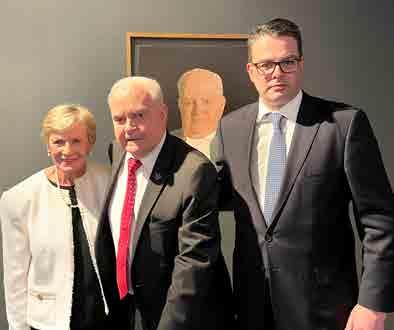
Committee also works to promote access to, and appreciation of, the collections by the wider community as well as the Bar.
In the period from 1 July 2021 to 30 June 2022, we took delivery of the following commissions:
1. Painted portrait of Brendan Murphy KC by Julius Killerby
2. Painted portrait of the Hon Linda Dessau AC by Angela Brennan
3. Photographic portrait of Richard Stanley QC by Garth Oriander
The Committee also accepted two gifts. The first is a portrait of the Honourable John Phillips AC QC, The Story of Azaria Chamberlain by Reinis Zusters, donated most generously by an anonymous silk. The second is a photographic portrait of Brian Shaw QC with his partner, Keith Beard, taken by Clive Starke.
All these works were installed under the expert eye of curator Murray White.
Also, portraits of the Honourable Kate McMillan by Jenny Watson and the Honourable Susan Kenny AM by Marie Mansfield were commissioned during the year. A portrait of the Honourable Geoffrey Nettle AC KC by Jude Rae (commissioned in 2020) is a work in progress, disrupted by the pandemic; completion is expected in 2023.
After several interruptions due to COVID-19 lockdowns, we were pleased to be able to host unveilings as follows:
› 17 November 2021 – the bust of Alfred Deakin, by Stephen Benwell, was unveiled in the presence of the artist, with a lecture by Emeritus Professor Judith Brett;
› 25 November 2021 – a private viewing of the portrait of Brendan Murphy KC with the family and the artist;
› 8 December 2021 – the photo portrait of Richard Stanley QC was unveiled by Jeremy Ruskin KC;
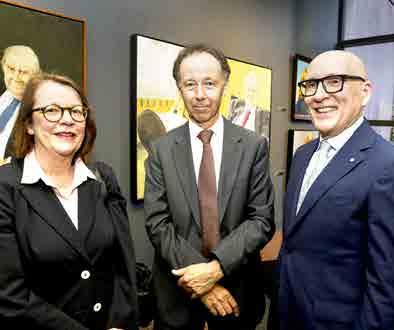
› 16 December 2021 – the photo portrait of Brian Shaw QC was unveiled by the Honourable Michelle Gordon AC;
› 3 March 2022 – Vic Bar – A History of the Victorian Bar by Dr Peter Yule was launched by the Honourable Michelle Gordon AC, and copies were distributed to members of the Bar;
› 15 March 2022 – portraits of Ron Merkel KC, Julian Burnside AO KC and William Ah Ket were unveiled by Siobhán Ryan KC and Associate Prof. Andrew Godwin (standing in for AttorneyGeneral Victoria, the Honourable Jaclyn Symes and;
› 14 June 2022 – a portrait of Brendan Murphy KC by Julius Killerby.
The Peter O’Callaghan QC Gallery is a public art gallery. It participated in PHOTO 2022, a Melbourne and regional Victoria event showcasing local and international photographers, from 29 April to 22 May 2022 on the theme of “Being Human”. Our exhibition was an Australian exclusive showing of two suites by French/Algerian photographer Mohamed Bourouissa, ‘Peripherique and Shoplifters’. Donations from Bar members fully funded the cost of mounting the exhibition.
As part of Law Week 2022, the Committee hosted an ‘In Conversation’ evening with photographer Bill Henson and the Honourable Kenneth Hayne AC KC, exploring the relationship between artist and sitter.
In a joint initiative with the Bar’s Indigenous Justice Committee, the Committee had framed photographic portraits of Indigenous Victorian Bar members by Indigenous photographer, James Henry. The portraits were hung in the dhumba djerring room on Level 1, Owen Dixon Chambers East.
All the above occurred in a pandemic year marked by two lockdowns totalling 89 days from 1 July 2021.
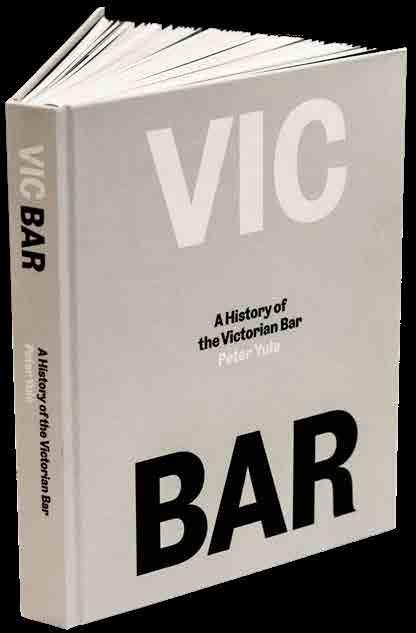
Sadly, we also must report the theft of items from the vitrines in the Peter O’Callaghan QC Gallery on a weekend in early March 2022. These included the nineteenth-century Silver Cigarette Case, an embodiment of the Bar’s pro bono tradition (see Victorian Bar News, Issue 158, Summer 2015-16, pp 32-3). The culprit was captured by police three weeks later in connection with another burglary in the city. However, to date, our items have not been recovered. The Age newspaper published an article about the theft and the history of the Silver Cigarette Case on 1 August 2022.
Committee as at 30 June 2022: Mark Robins KC (Chair), Robyn Sweet (Deputy Chair), David Gilbertson KC, Michael Flynn KC, Benjamin Murphy, Dean Luxton, Edward Gisonda, Jane Sharp, Andrew Burnett, Justin Mereine, and Lana Collaris.
The Audit Finance and Risk Committee (AFRC) acknowledges and is deeply grateful for the support of Mark Bryant (Manager –Finance & Membership) and all of the other diligent members of the Bar Office.
2022 activities and achievements: The AFRC oversees the Bar’s budget and annual reporting delegations and monitors and maintains the Bar’s risk register. Its most important responsibility is to oversee the preparation of the budget and end-of-year accounts and to make recommendations about these matters to Bar Council. In discharging its obligations, the AFRC liaises with the Bar management and external auditors.
The AFRC, working closely with the Bar management, recommended a budget to the Bar Council, which enabled the reduction in subscription fees by 5% for the great majority of barristers in Category A Part I for the 2022-2023 financial year. The AFRC gratefully acknowledges the dividend declared by Barristers Chambers Limited in favour of the Bar for FY 2021-2022, which effectively enabled this subscription reduction to be ‘fully funded’. The Bar Council, after due consideration, approved the proposed reduced subscriptions.
Further to its regular oversight activities, this year the AFRC:
› reviewed the risk register;
› reviewed the Professional Standards Improvement Plan;
› reviewed the Risk Management and Policy Framework;
› made recommendations to Bar Council as to the commencement of a review process of the JB Were Investment Fund, which review is pending subject to the implementation of the Bar’s major IT Project in the 2022-2023 financial year.
Committee as at 30 June 2022: Richard Dalton KC (Chair), Rachel Walsh (Deputy Chair), Darren Mort, Stephen Moloney, Peter Clarke, Romauld Andrew, Phillip Hayes, Robert O’Neill, Zoe Maud, Andrew Meagher, Premala Thiagarajan and Lara Collaris (Bar Council representative).
With the pandemic persisting into a second year, the CPD Program continued to be delivered primarily through virtual seminars, with remote attendance by speakers and the audience.
Many participants attended the seminars from home. These seminars continued to be recorded for later viewing via the Bar’s learning management system.
The CPD Committee held three meetings in 2021/2022: 24 August 2021 (via Zoom), 22 November 2021, 8 February 2022 and 12 May 2022. The main activities of the CPD Committee in 2021 were:
› Facilitating the content and delivery of the CPD Program, including the rollout of some CPD sessions ‘fundamentals’, the development of an updated and comprehensive CPD Guidelines document, and the development of online feedback surveys about the quality of CPD sessions.
› Participating in consultations for the Bar’s and the VLSB+C’s reviews into legal education.
› Overseeing the activities of the Victorian Bar’s Education Team in providing administrative support and resources to Bar Committees and Associations for the scheduling and delivery of their CPD sessions.
› Providing advice and guidance to barristers on whether certain sessions or other activities attract CPD points (and any caps on points for such sessions/activities).
› Conducting a review of governing documents and policies, including the CPD Charter and the CPD Rules.
On 25 February 2022, the CPD Committee launched the Junior Bar Conference in conjunction with the New Barristers’ Committee. Fortunately, after being postponed throughout 2021 due to COVID-19, the conference was conducted in person, enhancing the learning and networking experience for all attendees.
With COVID -19 restrictions easing in Q2 of 2022, the format of CPD seminars moved to a combination of in-person seminars in the Neil McPhee room and remote deliveries via live stream and/or Zoom. The number of participants attending in-person seminars steadily increased, but the option to join a CPD seminar remotely has continued to be popular.
Most CPD seminars were recorded for members to later view via the Bar’s learning management system.
In 2022, the main priority for the CPD Committee is to improve the range and quality of the Bar’s CPD program. To that end, the CPD Committee and the Education Team, in accordance with the CPD Guidelines, are assisting Bar Committees and Bar Associations in preparing and implementing CPD Plans with a view to developing a range of suitable topics that meet the core CPD criteria, including practical ethics content.
The Committee thanks those barristers who served on the CPD committee in 2021, and Nina Massara, Michelle James and Golam Kibria of the Bar’s Education Team.
The Committee also thanks retiring committee members for their valued service to the Committee. Particular gratitude is extended to Oren Bigos KC for his role in the Committee as a member for several years and as Chair in 2020 and 2021.
Committee as at 30 June 2022: The Counsel Committee was significantly re-constituted in November 2021, consisting from that date of Charles Shaw KC (Chair), Robert Hay KC, Marylyn Smallwood SC, Benjamin Murphy, Dr Robin Smith, Nawaar Hassan and Nicholas Phillpott. It was assisted by Sarah Cherry (Honorary Secretary).
The Committee thanks those members who retired in November 2021: Ian Freckelton AO KC (Chair), Róisín Annesley KC, Eugene Wheelahan KC, Darryl Burnett and Ben Jellis.
The committee is appointed pursuant to clause 63 of the Constitution of the Victorian Bar. It is comprised solely of members of the Bar Council. It considers matters in relation to the grant, renewal, variation, suspension or cancellation of practising certificates and applications to sign the Roll of Counsel and makes recommendations to the Bar Council. The Committee also deals with matters relating to the removal of members’ names from the Roll pursuant to the show-cause procedure set out in Part 14 of the Constitution.
The Committee meets as necessary, depending on the work of the Committee. Since the last report, it has met eight times.
The 2022-23 practising certificate renewal cycle necessitated the review of 14 disclosures for recommendation to the Bar Council.
Pursuant to the Bar’s Protocols for Dealing with Disclosures, the Honorary Secretary reviewed and made recommendations on a further 38 disclosures made by September 2021 Reader applicants and 36 disclosures by March 2022 Reader applicants. Four of those applications were referred to the committee for determination.
The Committee considered seven matters arising out of outof-cycle disclosures relating to fit and proper person issues or disclosure of automatic show cause events pursuant to Section 88 of the Legal Profession Uniform Law. As of 30 June 2022, five of those matters had been finalised, and two remained the subject of a continuing investigation.
The committee monitors compliance with conditions placed on barrister practising certificates as well as undertakings given by barristers in relation to their practising certificates. As of 30 June 2022, 21 practising certificate restrictions and undertakings were being monitored for compliance.
Overall, including suitability matters disclosed as part of the 202223 practising certificate renewal cycle and out-of-cycle disclosures, the committee finalised 19 matters from July 2021 to June 2022.
The committee is grateful for the support provided by the Victorian Bar Office, in particular Kai Li Zhu, the Bar’s Senior In-House Legal Counsel, for her outstanding, comprehensive and cheerful support in a relation to the work of the committee and the support of the Honorary Secretary, Sarah Cherry.
Committee as at 30 June 2022: Barbara Myers KC (Chair), Astrid Haban-Beer (Deputy Chair), Paul Panayi (Secretary), Andrew Woods (Acting Secretary), Natalie Campbell, Louis Hawas, Matthew Minucci, Carl Moller, Shawn Rajanayagam, Jayr Teng, Michael Wyles KC and Dr Michelle Sharpe (Bar Council representative).
Ongoing work of the Committee:
The EDC continued to participate in and inform the Bar’s policy review and development of relevant policies. The EDC also authored or contributed to policy submissions on behalf of the Bar, and participated in wider consultations with the broader legal community, such as with the Courts, Law Institute of Victoria, the Law Council of Australia, the Australian Bar Association, the Department of Justice, Victoria Legal Aid, and with the community legal sector and interest group associations (such as the Women Barristers Association, Australian Women Lawyers, Women in Crime, and the Asian Australian Lawyers Alliance).
EDC members provided feedback or participated in consultations on:
› LIV’s sexual harassment training module pilot;
› The Department of Justice and Community Safety Model Defamation Law Review (in respect of sexual harassment);
› Consultation with the Human Rights Law Centre on gender and culturally diverse equitable briefing policy practices;
› County Court name pronunciation protocol;
› Disability contact officer liaison with Courts;
› The Human Rights Law Centre’s equitable briefing policy.
CPDs/seminars delivered or being progressed:
› Culturally diverse briefing practices (in conjunction with VLA);
› Iftar dinner panel The Power of Law in Promoting Interfaith and Intercultural Respect on 13 April 2022;
› Sexual harassment awareness training for silk applicants;
› LGBTIQ Law Reform: General Update;
› Presentations to Readers’ Group on diversity issues at the Bar;
› Gendered Violence and Legal Practice (in association with the Starts with Us project);
› Intersectionality in the Profession Report (in association with the Starts with Us project);
› Association between wellbeing and sexual harassment and bullying.
Working groups
The EDC has committee representatives on its active Working Groups (WG). The Working Groups report back to the EDC. In brief, the WG have worked on the following initiatives:
1. Race, Ethnicity and Cultural Diversity Working Group (Chairs – Astrid Haban-Beer and Miguel Belmar Salas)
› Cultural diversity student internship in conjunction with Student Engagement Committee. This has, in principle, support from the Supreme Court, the Federal Court, the County Court, and the Victorian Bar, and it is hoped to commence the internships in 2023;
› Diversity data collection consultation with the Legal Services Board;
› Victorian Bar Iftar (Ramadan) dinner;
› Joint CPD with Victoria Legal Aid to encourage briefing culturally diverse barristers.
2. Gender Equality Working Group (Chair – Natalie Campbell)
› Sexual harassment CPD in conjunction with the WBA;
› Gender equitable briefing;
› Supporting the Women’s Legal Service, It Starts With Us gender equity research.
3. LGBTIQ+ Working Group (Chairs – Christopher McDermott and Elizabeth Bennett SC).
Its principal work is developing quality CPDs, developing web resources for the Bar’s membership, engaging with other
LGBTIQ legal networks, and providing formal and informal support to LGBTIQ barristers, including appropriately raising sensitive issues that may require improvement across the Bar. The existence of the working group has positively impacted the development of members of our Bar who may have been reluctant to be visible or identify as a member of the LGBTIQ community.
4. Disability Working Group (Co-chairs – Malcolm Harding SC and Carl Moller)
› Courts disability contact officer liaison project;
› Victorian Bar disability action plan;
› Ongoing consultation with Dr Ben Gauntlett, Disability Discrimination Commissioner.
The Chair would like to thank the dedicated EDC members for their significant contributions over the year.
Committee as at 30 June 2022: Lisa Hannon KC (Chair), James Barber (Deputy Chair), Ian Waller KC, Daniel Gurvich KC, Andrew Hanak KC, Marylyn Smallwood SC (Bar Council Representative), Sam Tatarka, Paul Lawrie, Sarah Cherry, Paul Kounnas, Alexandra Golding, Carmen Currie, Benjamin Jellis, Leana Papaelia, Dimitri Ternovski and Lucy Line.
The Ethics Committee comprises experienced barristers across all major practice areas who are selected by Bar Council for their knowledge of Bar ethical rules and their dedication to assisting the Bar and its members to navigate and resolve ethical issues and dilemmas that from time to time confront them. The Ethics Committee is ably supported by Bar Office In-House Lawyer Fernando Gallieto.
The Ethic Committee carries out a number of important functions. First, the Committee continues to provide advice and, if requested or required, formal resolutions, to individual members of the Bar confronted with a situation that raises an ethical difficulty. Advice and resolutions are often provided in urgent circumstances and frequently within a short time of a request being made.
› In the 2021 calendar year, 75 formal resolutions were provided to members of the Bar, an increase on each of the two previous years. A large proportion was provided within 24 hours of being requested.
› Second, on many other occasions informal discussions were held with individual members of the Bar who did not require a formal resolution, but who wished to discuss an ethical issue, or what they thought might be an ethical issue, with a member of the Committee. The availability of this process is an important means by which members of the Bar may seek assistance and reassurance on ethical questions which may not require formal resolution. It is of particular assistance to more junior members of our Bar.
› Third, the Ethics Committee is from time to time consulted by Bar Council on a range of matters, including on ethical issues that have arisen, and for assistance in responding to relevant matters arising in relation to draft legislation, proposed law reform and other matters affecting the regulation of barristers.
› Fourth, members of the Ethics Committee conducted or contributed to seminars for the continuing professional development of members of the Bar, notably:
› on 7 October 2021, a seminar on maintaining professional boundaries;
› on 27 September 2021, a seminar on ethical crossexamination; and
› on 25 May 2021, a seminar on ethical issues for criminal barristers.
› This aspect of the Committee’s remit is anticipated to take on greater emphasis as a consequence of recent recommendations by both the Royal Commission into the Management of Police Informants and the Victorian Legal Services Board & Commissioner, each of which seeks to emphasise the importance of practical ethics training in the delivery of the Bar’s CPD program. To this end, the Committee has nominated a dedicated member, Leana Papaelia, to manage the increasing number of requests for Ethics Committee assistance in CPD delivery. I am grateful for Leana’s willingness to take on this specific role.
› Fifth, members of the Ethics Committee assisted in teaching the ethics component of the Readers’ Course, usually by way of an introductory seminar, and a half-day practical workshop.
› Sixth, the Ethics Committee conducted grievance procedures between barristers under the Bar’s Grievance Protocol. In the 2021 calendar year, the Ethics Committee conducted three such grievance procedures, all of which were resolved or withdrawn.
I sincerely thank the Committee’s previous Chair, Peter Chadwick KC, for his dedicated service over more than 10 years on the Committee, including two years as Chair and, before that, three years as Deputy Chair. Peter has made a very substantial contribution to the work of the Committee and through it to the Bar as a whole. At all times Peter acted with great wisdom, sensitivity, common sense, and a gentle sense of humour. The Committee is most grateful to Peter for his excellent work.
I also acknowledge with gratitude the substantial service of the departed members of the Ethics Committee: Charles Shaw KC (including as former Deputy Chair), Andrew Strum KC (as his Honour then was), Stewart Maiden KC, Fiona Ellis, Simon Pitt, Justin Wheelahan, Lucy Kirwan and Simon Fuller.
I thank Fernando Gallieto of the Bar Office for his hard work and the great support he has provided to the Ethics Committee throughout the year, particularly in respect of requests for ethical assistance that require attention at short notice.
The Ethics Committee continues to play a very important role in the work and life of the Bar. The nature of barristers’ work and sometimes their conflicting duties to clients, to instructing solicitors, to the Courts and to the administration of justice, inevitably raise from time-to-time ethical dilemmas that barristers need assistance to resolve, often at very short notice. This can add greatly to the significant stress to which a barrister may already be subjected. Sometimes ethical dilemmas can be very difficult to resolve. The collaborative approach that members of the Committee adopt in dealing with the problems that are presented to the Committee represents a large part of what makes the work of the Committee satisfying for its members. And the evidently heartfelt thanks that the Committee often receives from barristers to whom it has provided resolutions or advice is always gratifying.
Committee as at 30 June 2022: Dr Michelle Sharpe (Chair), Paul Kounnas (Deputy Chair), Julie Davies, Ashley Halphen, Shaun Ginsbourg, Fiona Batten, Luke Stanistreet, Nicholas Walter, Scott Cromb and Robert Hay KC (Bar Council representative).
The Committee continued its work this year by hosting webinars on various wellbeing topics. These webinars were recorded and added to the resources available on the Wellbeing Portal hosted on the Victorian Bar’s website. The Committee is continuing to improve the Portal by marshalling and posting material that explicitly addresses matters that uniquely impact the wellbeing of barristers. The Committee has been assisted in this work by Bernadette Healy of Re-Vision Group and Roisin Ryan of the Victorian Bar Office.
This year the Committee, together with the Victorian Bar Office, marked ‘R U OK?’ Day, on 8 September 2022, with a stand in the Peter O’Callaghan QC Gallery and social media posts encouraging people to ask: ‘R U OK?’
The Committee has continued to assist barristers this year by fielding inquiries from barristers and clerks about wellbeing issues. The Committee also met with the Judicial Commission of Victoria to share its insights on bullying and harassment.
Committee as at 30 June 2022: Alistair Pound SC (Chair), Paul Hayes KC (Deputy Chair), Gavin Silbert KC, Tomaso Di Lallo, David Colman, Stephen Moloney, Anthony Krohn, Rohan Miller, Dr Jason Harkess, Stella Gold, Nicholas Goodfellow, Eugenia Levine, Rachel Walsh, Adam Chernok, Julia Kretzenbacher, Julie Buxton, Alex James-Martin and Julian Murphy.
The Committee thanks the following members who retired at 31 December 2021: Felicity Gerry KC, Susan Borg, Adam McLean, Douglas Laidlaw, Hugo de Kock, Andrew Yuile, Roshena Campbell, Shanta Martin and Rowan Minson.
The Committee’s remit
The Human Rights Committee is one of the Bar Council’s longest-standing policy advisory committees. The Committee is responsible for assisting and advising the Bar Council on matters related to the recognition, protection and enforcement of human rights under Commonwealth and Victorian law.
Activities of the Committee in 2021-2022
During 2021-22, the Committee met regularly and considered a wide range of topics. Among other matters, the Committee continued to monitor the State and Commonwealth Governments’ responses to the COVID-19 pandemic. It assisted the Bar Council in its dealings with the Victorian Government in relation to the Public Health and Wellbeing Act Amendment (Pandemic Management) Bill 2021 (Vic). The Committee also provided advice to the Bar Council in relation to the Religious Discrimination Bill 2021 (Cth), the Fraudulent Debtors Act 1958 (Vic) and the Monitoring of Places of Detention by the United Nations Subcommittee on Prevention of Torture (OPCAT) Bill 2022 (Vic) and contributed to the LCA’s revised death penalty policy statement and its submission to the review of the OECD guidelines on human rights compliance by multi-national enterprises.
The Committee has also conducted CPD seminars on the Charter and (together with the Indigenous Justice Committee) the campaign to raise the age of criminal responsibility. During the period under report, Shanta Martin also served as a member of the LCA’s Advisory Committee on Business and Human Rights.
Committee as at 30 June 2022: The Hon Robert Redlich AM KC (Chair), Peter Chadwick KC, David Hallowes SC (ex-officio), Richard P Dalton KC, Patrick Doyle SC and Ruth Shann SC.
The Indictable Crime Certificate (ICC) is an accreditation and quality assurance program, overseen by the Indictable Crime Certificate Committee (ICCC) on behalf of the Victorian Bar in conjunction with Victoria Legal Aid.
In 2021-22, the ICCC received 13 new applications, taking the total number of received applications to 376. The 2021-22 period saw 19 ICC holders renew their certificates. Some of the accreditation components could not be delivered due to the persisting social distancing requirements. Applicants who were impacted were awarded extensions to fulfil these requirements. Extensions for renewal of certification were also granted to those certificate holders under financial stress due to COVID-19.
A full review of the ICC accreditation scheme was launched in May 2020 to determine whether it provides suitable quality assurance and is fit for purpose. Due to ongoing disruption brought about by COVID-19, the project was put on hold and in
2021 a steering committee was appointed to conduct a review. The final report will be presented to Bar Council in late 2022.
The committee thanks retiring committee members: Paul Holdenson KC, Simon Marks KC, Ian R L Freckelton AO KC, Sam Hay KC and Sarah Keating for their valuable contribution to the work of the committee. The committee also warmly acknowledges and thanks the Victorian Bar staff for their work in support of the committee, Nina Massara (until April 2022), Michelle James (since May 2022) and Golam Kibria.
Committee as at 30 June 2022: Anne Sheehan (Co-Chair), Timothy Goodwin (Co-Chair), Christopher McDermott (Secretary), Ben Ihle KC, Anthony Schlicht, Gordon Chisholm, Julie Buxton, Serena Armstrong, Katherine Stowell, John Heard, Julian Murphy and Daniel Nguyen (Bar Council representative).
The Committee thanks those members who retired during the year: Jeremy Whelen, Nicholas Goodfellow, Rabea Khan, Paul Kounnas (Bar Council representative).
The Committee also thanks the following judicial consultants for their valued and continuing support: Justice of Appeal Stephen Kaye (Court of Appeal), Justice Mordecai Bromberg (Federal Court), Judge Arushan Pillay (County Court).
2021-2022 was a busy year for the Committee.
The Bar’s third Reconciliation Action Plan (RAP) was launched officially on 1 June 2022 in the Neil McPhee Room. Attendees were privileged to experience a moving and personal Welcome to Country from Wurundjeri Elder Uncle Ringo Terrick and to hear insights from Victoria’s Commissioner for Aboriginal Children and Young People, Yorta Yorta woman, Meena Singh, about current challenges in the justice system faced by Aboriginal children and young people.
As part of the Bar’s commitment to furthering awareness about reconciliation, the previously unnamed conference room on Level 1, Owen Dixon Chambers East, has been named ‘dhumba djerring’, which carries the meaning ‘talk together’. Thanks to the Wurundjeri Woi Wurrung Cultural Heritage Aboriginal Corporation for the naming. The Committee also unveiled portraits of current and former Indigenous members of the Victorian Bar that have been positioned in the dhumba djerring room. The Committee encourages everyone to view these portraits. It expresses its sincere gratitude to Serena Armstrong and Siobhán Ryan KC, Chair of the Arts and Collections Committee (and its membership), for their efforts to organise these portraits during COVID-19 restrictions.
On the 30th Anniversary of Mabo v Queensland (No 2) (1992) 175 CLR 1 which coincided with National Reconciliation Week,
the Committee encouraged Bar members to familiarise themselves with the RAP and to take positive and proactive steps to assist the Bar in effectively implementing it overall.
The Committee has continued to implement and oversee several programs for Indigenous barristers, law graduates and law students, designed to assist them in developing and maintaining successful practices and to attract more of their number to the legal profession. These include: › a mentoring program establishing close ties between Indigenous law students and graduates and both Judges and barristers ensuring that at least one CPD seminar on legal issues relating to Indigenous people and/or working with Indigenous people is presented each year.
The Indigenous clerkship program has again been successfully implemented this year, after being postponed due to COVID-19 restrictions in early 2021. This year, the program has expanded to include the County Court as a participating jurisdiction. The Committee is delighted that the County Court has come on board as a participant and thanks Neane Carter, Clerkship Alumni, and Judge Arushan Pillay and Judge My Anh Tran for their commitment to the program.
As of 30 June 2022, there are seven Indigenous barristers at the Bar. One Indigenous reader will be joining the September 2022 Reader’s Course.
Finally, the Committee relies heavily upon the Bar Office to assist in its work. For example, the Bar Office staff attend the Legal Profession Reconciliation Network meetings and assist in monitoring compliance with the RAP. The Indigenous Justice Committee sincerely thanks the staff of the Bar Office, in particular Kai Li Zhu, Fernando Gallieto and Roisin Ryan.
Committee as at 30 June 2022: Garry Bigmore KC (Chair), Michael Wise KC (Deputy Chair), Elizabeth Boros, Lionel Wirth, Angus Christophersen, Eliza Bergin, Gayann Walker, Annabel Tresise, Stephen Bunce and Andréa Skinner (Bar Council representative).
The Committee continues to strive to share and promulgate information about the technology-led change in the legal sector, opportunities for barristers to use technology to their advantage in their day-to-day practices, technology changes in courts and changes to how barristers may be briefed.
In 2021, COVID-19 continued to influence the rate of technological change reflected in those objectives. Even now, as the effects of the pandemic recede, it is likely that virtual hearings, conferences and mediations will continue in appropriate cases.
During 2021, Committee members developed Microsoft Word templates for use by barristers who either subscribe to BCL’s Office 365 (Enterprise) offering or who download them from
the Committee’s page at https://www.vicbar.com.au/members/ community/innovation-technology
The Committee also continues to monitor cyber security and cloud storage, liaising regularly with BCL.
In 2021, on the Committee’s recommendation, the Bar introduced the “Reverse Mentorship Scheme”. Reverse mentoring allows people with more seniority in a given environment to benefit from the experiences, insights and skills of those who are more junior to them. Potential participants complete an online form that allows them to give an indication of the general practice areas in which they work (or, for the mentors, in which they would like to work). The aim is to link barristers in similar practice areas so that mentors and mentees can develop solutions and systems that are useful to them both.
To preserve confidentiality, two nominated members of the Committee administer the Reverse Mentorship scheme and already, several mentorships have been established. The scheme is continuing in 2022, and feedback from participants has been sought.
It is anticipated that, after three meetings between each mentor and mentee, the following skills will be developed:
› Managing matters and briefs by email.
› Accepting electronic briefs.
› Using digital documents in court hearings.
› Editing PDF documents: markups, highlights, tabs/ bookmarks, etc.
› Formatting Word documents: headings, tables of contents, bullets and numbering, etc.
› Using all leading video conferencing platforms relevant to the practice area.
› Planning for cyber security and digital document security.
› Risk management planning includes issues arising from working from home, internet outages, device damage and retrieving lost files.
› Establishing which devices, tools and software may be relevant and useful to the practice area.
Committee-sponsored CPD sessions took place on 9 August 2021 on optimising the use of Microsoft Word in practice, 29 September 2021 on navigating the world of eBriefs, 10 November 2021 on tips and tricks for using PDFs and 27 June 2022 on cryptocurrency assets (with an explanation by Laurence White of developments in legal and practical treatment of cryptocurrency assets, including in estate, family, and commercial areas).
The Committee’s 2022-2023 CPD programme will also comprise sessions on:
› Internet-based evidence (use of the Internet Archive/Way back Machine, adducing internet evidence and proof of facts in relation to online activities);
› Remote advocacy technology (best practices for remote appearances and tips for optional software and hardware tools to enhance advocacy);
› In-court technology (to be run in conjunction with representatives from courts/tribunals, outlining the resources available for in-court use of technology, tips for optional technologies and techniques that advocates can leverage and explanation of the “back-end” of court technologies and how courts/tribunals use technology).
Other CPD sessions in contemplation include topics on keeping operating systems and software up to date, using antivirus software, making multiple secure backups of electronic data regularly, tips for identifying scam emails, using cloud services and securely sharing electronic documents with instructors, clients, experts and witnesses.
The Committee continues to focus on supporting barristers to work with electronic briefs and to practise from home if necessary or convenient.
The Committee also endeavours to assist with the Bar’s current IT re-development.
Committee as at 30 June 2022: Remy van de Weil KC (Chair), Ben Ihle KC (Deputy Chair), Sarah Thomas, Hilary Bonney, Peter O’Farrell, Albert Dinelli, John (Jack) Tracey, Clare Cunliffe, Leigh Howard, Stragen Foo, Simon Fuller, Sophie Molyneux and Dr Robin Smith (Bar Council representative).
The following report contains a summary of the International Advocacy Training Committee’s (IATC) activities this year.
Activities of the IATC:
Solomon Islands:
› After the success of our remotely conducted appellate advocacy course in the Solomon Islands in June 2021, the IATC was approached by the Office of the Director of Public Prosecutions and the Public Solicitor’s Office to conduct the same course again for those unable to attend. It conducted a course using the same materials from 21-23 April 2022. As with the last occasion, the course was delivered by video-link.
› The 19 participants congregated at the Heritage Park Hotel in Honiara, and 12 members of the Bar conducted the course from their chambers or homes.
› Justice Maelyn Bird, a judge of the High Court of the Solomon Islands, and the first woman to be appointed to that Court, opened the course. Her Honour spoke of the course’s importance to advocacy in the Solomon Islands. Her speech set the tone for a very successful course. Mr Andrew Elborn, Counsellor – Governance and Justice, Australian High Commission also attended.
› The feedback from the ODPP and PSO was that the course was very well-received by the participants. A special thanks to Remy van de Wiel KC, Ian Upjohn KC, Stephen Russell, Sarah Thomas, Alan Hands, Emily Latif, Alan Ford, Albert Dinelli, Clare Cunliffe, Sophie Molyneux, Miguel Belmar and Andrew Pollock for giving up their time to assist.
› The IATC is in the process of seeking guidance from the Australia-Solomon Islands Justice Program as to what teaching is most required, and how best to deliver it in future. We are hopeful that a further course, to be delivered in person in Honiara, can occur within the next 6-9 months.
Papua New Guinea:
› In 2022 the Legal Training Institute in PNG faced delays in the delivery of its program. It was not ready and has asked the IATC to delay the delivery of its course originally planned for July.
› At this stage, the working group, headed by Peter O’Farrell, is trying to secure dates in November 2022 with a possible hybrid delivery model of four or five barristers travelling to Port Moresby with other coaches delivering content via Zoom.
Tonga:
› In late 2021 members of the IATC presented two CPD Seminars for the Law Society of Tonga via Zoom. These were coordinated with the support of the Lord Chief Justice of Tonga, Michael Whitten KC, and also the President of the Law Society of Tonga.
› Both seminars were well attended with more than 50 members of the profession in attendance.
› The Victorian Bar was invited to deliver more presentations in 2022. However, a natural disaster in Tonga, which occurred earlier in the year, has deferred plans. Vanuatu:
› An ‘online advocacy’ session was presented to a group of lawyers from the Vanuatu Attorney-General’s department, Prosecution Service and Public Lawyer’s office over the course of an afternoon in August. It was delivered via Zoom by Ben Ihle KC and Patrick Coleridge.
› The session was very well received and, subject to interest and necessity, similar programs are to be offered in the future to other developing nations embracing online advocacy.
› The Vanuatu working group, headed by Sarah Thomas, has also developed a trial advocacy program for Vanuatu, to be delivered in-person, in the first week of November 2022.
› The Course, to be administered by five members of the Victorian Bar and a local member of the judiciary, will run over three days with moot problems covering injunctions, and a criminal trial pursuant to Vanuatu law.
Singapore:
› The IATC continues to develop plans with the aim of establishing ongoing training opportunities between the Victorian Bar via the IATC and the Law Society of Singapore.
Overseas readers:
› One overseas reader, whose earlier placement in the 2020 Bar Readers’ Course was deferred (Anthony Paru), commenced the September 2022 course. IATC Member, Peter O’Farrell is his mentor.
› The second deferred applicant indicated that she would not take her place due to travel funding difficulties. This left a place open in September 2022, which was unable to be filled due to the continued uncertainty created by the pandemic.
Working groups:
› The IATC has established working groups, comprised entirely of IATC members, for the development and delivery of advocacy training to each of the five nations referred to above, and in relation to international readers. They exist for those purposes which are ongoing.
› Each of the courses and programs delivered under the auspices of the IATC are initially developed by the respective working groups. They are reviewed and approved by the IATC executive before delivery.
› It is the view of the executive of the IATC that its working groups are adequately resourced and supported and that the processes of content approval are appropriate and effective.
Recognition of Phillip Corbett KC’s service:
› The IATC continues to acknowledge the exceptional contribution of Phillip Corbett KC to international advocacy training and the influence that has on the recognition and enforcement of the rule of law, especially in developing nations.
Committee as at 30 June 2022: John Noonan KC (Chair), Gerard Meehan (Deputy Chair), Michelle Britbart KC, James Barber, Tristan Sedal, Roslyn Kaye, Matthew Hooper and Mark Robins KC (Bar Council representative).
In the second half of 2021, the Victorian Bar Council determined to reconstitute an Insurance Committee of the Bar.
The Bar Council was concerned that the previous Insurance Committee had been disbanded some years ago and that there was no committee of the Bar whose remit was to review the terms and conditions of the current professional indemnity policy on an ongoing basis offered by the Legal Practitioners’ Liability Committee (LPLC) to barristers. Recent experience has demonstrated that whilst the $2 million compulsory layer of cover is inclusive of defence costs, and the Professional Standards Scheme caps liability at $2 million for scheme members, barristers might be required to make up a shortfall (which could be significant) in the event of a costs order. Further, the ability of insured barristers to influence the conduct of proceedings seemed to be limited or non-existent.
Accordingly, the Insurance Committee of the Bar was reconstituted to review the LPLC policy, its terms of cover, premium levels, and its failure to cover barristers in the event of disciplinary proceedings which might arise in the circumstances unrelated to any alleged negligence.
Essentially, the Insurance Committee is concerned with maintaining an ongoing prudential review of Bar insurance issues. This includes obtaining from the LPLC and reviewing relevant claims data, gaining an understanding of the professional indemnity insurance cover available to barristers in other states in Australia, and the scope of cover and premium levels on offer, considering the suitability of the current LPLC insurance and lobbying the LPLC for improvements to the barrister’s policy wordings.
Generally, the Bar has been advantaged by having the LPLC as an insurer. Individual premiums have reduced since the Bar took on the LPLC as our insurer, although issues with policy wording and cover remain.
As an initial task, the Committee has sought and obtained recent claims data, which the Bar had not sought after 2017.
As a first step, the Committee considered in November 2021 the LPLC proposed revised policy wording and explanatory memorandum. The Committee met with Justin Toohey, Chief Executive of the LPLC, on 29 November 2021. The Committee raised with Mr Toohey a number of issues concerning the LPLC proposed policy terms changes and, more broadly, the Committee’s desire to see the policy wording better fit the barrister’s practice as a sole trader specialist advocate, including, in due course, cover for disciplinary complaints. Issues with the costs inclusive policy were also raised. The Committee requested current policy claims and reserve data which the LPLC subsequently provided.
The Insurance Committee intends to work with the LPLC to improve the policy to reflect better barrister’s practice and insurance risks, rather than merely duplicating what is essentially a solicitor’s policy wording. Although such changes are not possible before the present policy renewal process occurs, the Committee hopes to advance these objectives prior to the subsequent renewal of the policy. The Committee also intends over the course of this year to explore the availability of alternative insurers in order to benchmark premium levels and scope of cover.
Subsequent to the Committee meeting with Mr Toohey, he wrote to the Committee indicating that the LPLC is happy to engage in discussions and subsequently provided aggregated claims data over the five years from 2016/2017 to 2020/2021 on a confidential basis.
In conclusion, the Insurance Committee proposes to pursue whether an optional extension to cover may be possible with
respect to disciplinary complaints, reassess the suitability of the terms of cover for barristers, and develop a position with respect to the current costs-inclusive policy limit. The Committee hopes to make some progress on these issues through the remainder of 2022.
Committee as at 30 June 2022: Dr Paul Vout KC (Chair), Peter Willis SC (Deputy Chair), Richard Brear, John Gordon, Cilla Brookes (CPD Organiser), Jonathan Wilkinson, Dr Steven Stern (Secretary), Lucy Line (CPD Organiser), Andrew Burnett, Nicholas Bird and Nawaar Hassan (Bar Council representative).
The Committee thanks its previous Chair, Mark Robins KC, and Ray Ternes, who retired in December 2021.
The Committee meets formally four times a year, with Law Library of Victoria (LLV) Director Laurie Atkinson and Vic Bar’s Manager Library Reference Services, Belinda Schembri, routinely invited to Committee meetings. Additional working bees are conducted.
Working closely with the LLV, the Committee provides management of the Richard Griffith Library (RGL) and library services to barristers. The Committee oversees the Bar’s collection of physical law report volumes and textbooks and journals, available at all hours to members of the Bar.
These are housed in the RGL on the first floor of Owen Dixon West, in the adjoining Neil McPhee Room and Bar Council room, and in various ‘branch libraries’ within BCL’s buildings, courtesy of the tenants of the relevant floors and BCL.
Additionally, in cooperation with the LLV, the Committee provides access to a wide and increasing range of digital legal resources (including, through three computer terminals in the RGL, access to the full suite of electronic resources available in the Supreme Court Library) and provides training and legal research assistance.
For more than nine months of the period under report, the Supreme Court Library was not available to visit due to restrictions on access in response to the COVID-19 pandemic. During that time, the RGL provided a lifeline for many barristers. Committee members assisted barristers in accessing legal research remotely through the LLV’s online portal. Effective advocacy by members of the Committee resulted in the introduction in early 2022 of ‘by appointment’ visits to the Supreme Court Library while the Court building continued to be closed.
From 30 March 2022, staff from the LLV resumed their part-time physical presence in the RGL: Nadine Mann at RGL on Wednesdays from 9 am to 11 am and Alissa Duke on Thursdays from 1 pm to 3 pm. This is provided pursuant to a service agreement between the Bar Council and the LLV (LLV Agreement) renewed on 1 July 2021 for another three years.
Using the LLV Agreement’s annual budget for purchases, the Committee updated and extended the textbook collection, with input from specialist practice associations of the Bar, the Committee and LLV. Further, the law reports held in the Bar library’s numerous branch libraries were added to the Bar Library catalogue. The LLV’s current catalogue of the Victorian Bar collection of books and law reports can be searched or browsed online by clicking here. https://courts.sdp.sirsidynix.net.au/client/ en_AU/llv/search/results?qf=LIBRARY%09Library%091%3AVVICB AR%09VicBar&te=ILS&lm=LLV_PRINT-COLLECTION&st=TL
Eight CPD sessions were held by the LLV for barristers during the reporting period, with 346 barristers attending. A further 41 LLV CPD sessions were open to all members of the legal profession to attend. Due to COVID-19 restrictions, these were mostly virtual. In April 2022, a successful, hybrid CPD session was conducted to highlight the Judicial College’s Scholarship for the Legal Community research program, presented by a range of Judges and other contributors, including the Committee Chair. See https://www. judicialcollege.vic.edu.au/resources/scholarship-legal-community
The Committee is the custodian of many valuable and historical texts and sets of law reports donated by their previous owners, distinguished members of the Bar and the judiciary. We record the acceptance of such donations and other records and the contributions of legal publishers gratefully. With pressure on shelf space as BCL refurbishes floors of chambers, concern about the storage and protection of donated items led the Committee to approach BCL Deputy Chair Sam Hay KC, and CEO Paul Clark about procuring long-term use of one or two rooms. The response was as swift as it was generous. In April 2022, BCL agreed to provide a long-term, gratis arrangement for a Bar Library Annexe and immediately demonstrated their commitment by providing and installing substantial quality shelving and assisting the Committee in moving a heritage set of Commonwealth Law Reports to the annexe.
The Committee extends its thanks to BCL for its generosity and responsiveness. In the coming year, the Committee will publicise the location of the Bar Library Annexe and its other branch libraries and seek to survey the Bar to understand its current needs for legal resources.
Committee as at 30 June 2022: Shane Lethlean (Chair), Scott Davison (Deputy Chair), John Simpson, Jamie Richardson, Matthew Follett, Thomas Warner, Alexander Manos, Charles Pym, Georgina Rhodes, Zoe Anderson, Nicholas Dodds and Maria Pilipasidis (Bar Council representative).
The New Barristers’ Committee (NBC) was established by Charter to advise and assist practising members of the Victorian Bar of up to six years’ call for their integration and support within the Bar.
The NBC held five meetings in 2022.
The NBC continued to promote the interests of new barristers during 2022 by:
› Establishing CPD seminars
› Hosting “Coffee with Silks” from various jurisdictions
› Planning social functions
› Assisting in the 2022 Junior Bar Conference
› Creating awareness of the “Open Door” policy of the Bar
› Taking up essential matters directly with the Victorian Bar Council.
The 2022 NBC’s two steering sub-committees, Education and Social, have continued to meet the needs of the Bar’s newest members, maintaining, in large part, the work of the 2021 NBC and its Chair, Erin Gardner.
The profession is still emerging from the significant impacts of the COVID-19 era and ‘depersonalisation’ consequences for barristers, including the advent of virtual courts and the previous lock-down restrictions on chambers life at the Bar.
The COVID-19 era has, moreover, had a profound impact on the junior Bar. The NBC has, throughout 2022, safe-guarded their shared nascent interests and increased the opportunities for collective collegial contact within the Bar environment.
Committee as at 30 June 2022: Dr Oren Bigos KC (Chair), Wiliam Lye OAM KC, Elizabeth Bennett SC, Justin Castelan, Sarah Keating, Christopher Brown, Tasman Fleming and Rachel Walsh.
Committee as at 30 June 2022: Matthew Harvey KC (Chair), Geraldine Gray (Deputy Chair), Meghan O’Sullivan KC, Nicholas Kanarev, Andrew Woods, Martin Guthrie, Adam Coote, Joel Silver, Willem Drent, Laura Hilly, Christopher Lum, Anna O’Callaghan, Michelle Zammit, and Maria Pilipasidis (Bar Council representative)
As of 2021 the Pro Bono Committee comprised of Meredith Schilling (Chair), Donald Farrands KC (Deputy Chair), Leslie Glick KC, Meghan O’Sullivan KC, Nicholas Kanarev, Adam Coote, Eugenia Levine, Laura Hilly, Willem Drent, Christopher Lum, Anna O’Callaghan, Bonnie Renou, and Darryl Burnett (Bar Council representative).
Following the Eureka Rebellion in December 1854, 13 men were committed to stand for trial on charges of high treason before the Supreme Court. Four barristers of our Bar represented the accused men pro bono. The tradition and commitment to work pro bono publico continues at the Victorian Bar.
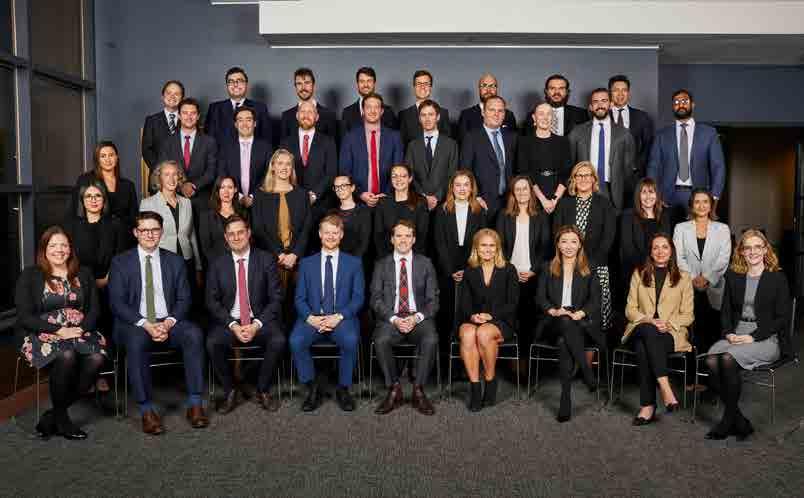
ABSENT:
The work of the Pro Bono Committee comprises three broad areas of activity. The first is the Victorian Bar Pro Bono Scheme. The second is the various Court referral schemes. The third is a collection of activities designed to facilitate the first two.
The Victorian Bar Pro Bono Scheme is administered by Justice Connect. People seeking the assistance of barristers pro bono may apply to Justice Connect via its online platform. Justice Connect then assesses the application’s eligibility, which involves determining whether it is appropriate that the person receive pro bono assistance and whether the person requires the assistance of a barrister.
In the last 12 months, the Committee has been working with Justice Connect to improve upon eligibility guidelines. It is anticipated that these will be confirmed shortly.
The various Court referral schemes facilitate pro bono services for self-represented litigants in cases that are already before courts. These schemes currently operate in the Victorian Supreme Court and Court of Appeal, the County Court, the Coroners Court, and the Federal Circuit and Family Court of Australia. These schemes advance the rule of law by assisting courts in the administration of justice, by giving people greater access to the courts, and by giving barristers the opportunity to hone their skills.
The additional activities which the Committee oversees are:
The Open Justice Project: This Project is a collaboration between the Faculty of Law at Monash University and the Victorian Bar. Now in its second year, the Open Justice Project provides Monash Law students with an opportunity to assist barristers working on pro bono matters.
Pro Bono Awards: The next awards will be in 2023.
Disaster Legal Help Victoria: Two members of the Committee represent the Victorian Bar as partners of Disaster Legal Help Victoria. This scheme is for the provision of pro bono assistance to Victorians affected by natural disaster in the State.
Continuing Professional Development: The Committee was involved in organising several CPD activities in 2021 – 2022.
Future directions: The Committee has begun discussions with representatives of the VCAT as to a potential pro bono referral scheme with that tribunal.
Finally, the Committee records its thanks to previous members who dedicated themselves to advancing the Committee’s work. In particular, it thanks Meredith Schilling for her tireless work and commitment for a number of years as Chair of the Committee.

THE VICTORIAN BAR MARCH 2022 READERS, BACK ROW (L-R): Tomas Acutt, Samuel Cooper, Dean Merriman, John Petras, D’Arcy Hope, Anthony Middleton, Joshua Sheppard, Eugene Twomey, Mark James SECOND ROW: Gabriel Chipkin, Rohan Phelps, Andrew McNaught, Simon Bobko, Vincent Vuu, Angus Willoughby, Kenny Cheng, Laurence Fudim, Andrew Hanna, Benedict Coxon, James Gray THIRD ROW: Angelika Yianoulatos, Catherine Jones Williams, Laila Hamzi, Harriet Geddes, Hugh Crosthwaite, Alexis Buckley, Celeste Shambrook, Brandan Cooper, Hannah Hofmann, Joshua Bridgett, Nicole Tyson, Hannah Canham, Sepideh Sadri, Alice Whardall, Alissa Crittenden, Jessica Hotchkin FRONT ROW: Katrina Hartman, Jessica MacKay, Tamir Katz, Michelle Button, Gisella Nip, Jakub Patela, Catherine Pase, Thomas Rawlinson, Greer Boe, Yasur Al-Azzawi, Kylie McInnis ABSENT: Mark Gioskos
Committee as at 30 June 2022: Justin Graham KC (Chair), Anthony Strahan KC (Deputy Chair), Chris O’Grady KC, Chris Archibald KC, Bronia Tulloch, Sarah Porritt, Patrick Over, Paul Kounnas, Albert Dinelli, Aphrodite Kouloubaritsis, Gordon Chisholm, Raini Zambelli, Robert Forrester, James McComish, Felicity Fox, Alyse Mobrici and Nicholas Phillpott (Bar Council representative).
During the year, the Readers’ Course Committee has continued to oversee the Readers’ Course and the Bar Exam in accordance with the Bar’s Application & Reading Regulations, in close consultation with Victorian Bar staff (Nina Massara, Michelle James and Nikki Walker).
The Course Review Working Group (CRWG) continued the refinement and improvement process of the Readers’ Course, which was established several years ago and overseen by the Chair and Deputy Chair of the Committee. Recommendations from the most recent reviews included changes to individual sessions (content and presenters) and the reduction of the length of the Course (from nine weeks to eight weeks), which recommendations were adopted and implemented in the March 2022 course. Further refinements were recommended by the CRWG and adopted by the Committee after a review of the March 2022 course. A review of the March 2022 course also involved significant input from a Bar Council working
group. The advocacy training methods and resources have also been the subject of review, which is the focus of a working group chaired by the Deputy Chair.
Reviewing the Course has been assisted and informed by improved feedback from readers (in terms of quantity, quality and timeliness), which was obtained via weekly email surveys and occasional group meetings with readers. The process for obtaining the improved feedback was overseen by a working group chaired by Sarah Porritt.
COVID-19 restrictions and lockdowns meant that the September 2021 Course (like much of the March 2021 Course) was conducted online via Zoom. It is a considerable achievement that the Victorian Bar could conduct the Readers’ Course, notwithstanding the protracted lockdowns that Victoria experienced in 2021. For this, the Committee and the Bar owe much to the resourcefulness and hard work of the Bar Education Team (Nina Massara and Nikki Walker, in particular), to the positivity and resilience of the readers and the generosity and commitment of the many volunteer presenters from the Bar and the Bench. The Readers’ Courses that were conducted in 2021 are fine examples of the collaborative manner in which people in our profession came together to tackle the challenges of that extraordinary time. The positive feedback received from readers and, separately, from Victorian Bar staff, presenters, committee members, and others involved in the courses in 2021 underscores the success of these collective endeavours.
With the lifting of restrictions in Melbourne, the March 2022 Course saw a very welcome return to in-person delivery. The Course commenced on 10 March 2022 with 48 readers and concluded with a signing ceremony on 5 May 2022. Social distancing practices were implemented, as were contingency plans (e.g. Livestream, videos) for readers who were forced to isolate themselves due to contracting COVID-19 or being a close contact.
Limited course numbers and the waiting list of successful exam candidates awaiting placement in a course (the ‘overhang’ issue) continued to pose a problem in 2021 and into 2022. The September 2021 course had 46 readers, and the March 2022 course had 48 readers. The September 2022 course had 46 readers, following difficulty filling one place reserved for an overseas candidate (a legacy of COVID-19 issues) and the late withdrawal of another candidate. At this point, pending the results of the October 2022 exam, 17 places have been allocated in the March 2023 course and three places in the September 2023 course.
During 2021, the Committee presented a proposal to Bar Council aimed at addressing the ‘overhang’ issue, suggesting an increase in the size of each Course to 54 readers. A review of the underlying issues and possible solutions was also proposed. Bar Council adopted the proposed review but not, the increase in the size of the course, and appointed Ray Finkelstein AO KC to conduct the review, assisted by some members of the Committee (and others). That review has been ongoing during 2022 and will report to Bar Council.
In 2021 and 2022, the Committee also reviewed and implemented some changes to mentor arrangements. The handbook for mentors has been improved, and a session was conducted for mentors of readers in September 2021, March 2022 and September 2022 courses at which mentors received information about the role (expectations, tips, suggestions etc.) and had an opportunity to ask and share information and experiences. The sessions were well received and very successful, and it is intended that these will continue. Following the difficulties of the last two years, it is likely that more work will be required managing and setting the expectations around the reading period in circumstances where both readers and mentors have become accustomed to remote working and may wish to continue that practice to a greater degree than occurred before 2020.
In 2021, the Committee (in conjunction with the Indigenous Justice Committee) developed and implemented a mentor programme for First Nations Bar Exam candidates. In the first implementation of the programme, two First Nations candidates were paired with barristers who had recently completed the exam and Course. Both candidates successfully passed the Bar Exam and gained places in the Readers’ Course. The reports from the candidates and their mentors were very favourable. The programme has been refined and continued in 2022. In
2022 the Committee also adopted a protocol for the conduct of Acknowledgements of Country and Welcomes to Country for the Readers’ Course and related events. Gordon Chisolm developed the protocol regarding the Bar’s RAP and policy in consultation with the Indigenous Justice Committee.
Exam:
In October 2021, the Bar successfully delivered an electronic exam – the second e-exam conducted in accordance with the recommendations of the 2019 Exam Review Panel Report to the Bar Council. The e-exam was overseen by a working group chaired by Lachlan Cameron and, more recently, Felicity Fox.
Overall, the ExamSoft software has proven to be an effective invigilation mechanism, with a very low rate of technical error experienced by candidates (less than 3%). The Committee developed rules, procedures and protocols for the e-exam in conjunction with the Bar Education Team.
In 2022, the pre-exam lecture sessions developed in 2021 and given by recent participants in the Readers’ Course continued. These were well attended and well received by candidates. In addition, Her Honour Judge Martine Marich has kindly continued to offer a podcast series, and she presented a webinar to exam candidates to assist their preparations for the exam. The Committee is very grateful to Her Honour.
The Bar continues to attract great interest within the profession as a vocational destination. There were 241 candidates who registered for the October 2021 exam, with 217 sitting on exam day. There were 88 successful candidates who passed the exam, with a total of 96 receiving offers to undertake the Readers’ Courses in 2022 and 2023. Those receiving offers included applicants for special consideration whose applications were granted by the Executive.
Of the 217 candidates, 52% were male, 47.5% were female, with 0.5% declining to indicate. The 88 candidates who passed the exam represent a pass rate of 40.6%. The exam continues to be prepared and overseen by the Chief Examiner (Dr Jason Harkess) and is reviewed by the standing Exam Review Panel, which is appointed each year by the Bar Council in accordance with the recommendations of the 2019 Exam Review Panel Report.
The International Internship Program, successfully launched in August 2019, was put on hold in 2020 and 2021 and could not be implemented in 2022 due to international border closures and related challenges. The program provides international applicants with an opportunity to secure an in-depth understanding of the administration of justice in Victoria through a placement program run by the Victorian Bar with assistance from the International Commission of Jurists (ICJ), the Federal Court and the County Court. Sarah Porritt chairs the working group in charge of the program, and the timing to reactivate the program is being explored.

Acknowledgements and Thanks:
The Committee acknowledges and extends a warm thank you to:
› Nina Massara (until April 2022), Michelle James (since May 2022) and Nikki Walker for their care, hard work and excellent service in administering the Readers’ Course and the Exam and in assisting the Committee;
› The retiring committee members (in November 2021) for their valued service and commitment to the work of the Committee and the Bar – with particular thanks to Dr Sue McNicol AM KC, Ray Finkelstein AO KC and Eugene Wheelahan KC for their long and dedicated service over many years, and to Ben Ihle KC and Diana Price amongst others for their important contributions;
› The many volunteer presenters, moot judges and mentors from the Bar and Bench whose generosity make the Readers’ Course possible and the success that it is.
Committee as at 30 June 2022: Tim Farhall (Chair), Sebastian Reid (Deputy Chair), Clive Madder, James Waters, Rachel Matson, Bonnie Renou, Priya Wakhlu, Matthew Weinman, Erik Dober, Georgina Rhodes and Daniel Nguyen (Bar Council representative).
The work of the Student Engagement Committee continued apace, both during the COVID-19 lockdowns and as barristers and students moved into the ‘new normal’.
The Committee continued its outreach program to high schools. Members presented or participated in webinars, advocacy training sessions and careers fairs for law students from most major Victorian law schools. The Committee also ran a panel presentation for Law Week 2022 entitled “CrossExamine A Barrister” and a webinar on the recent Sharma case, (Sharma vs the Minister for the Environment) broadcast directly into high school classrooms.
With the end of lockdowns, the Committee could finally run a pilot of its formal shadowing program in collaboration with Victoria University (VU). The pilot was a great success, and the Committee is now planning to roll out the program more broadly next year. Both VU and other major Victorian universities have expressed strong interest in participating.
The Committee continues to collaborate with the Pro Bono Committee and Monash University to deliver the Open Justice Project. This project, to enable later-year students to provide assistance to barristers at the Victorian Bar in pro bono matters, continues to receive overwhelmingly positive feedback from both students and barristers.
Planning for the Victorian Bar Mooting Competition, where the winning senior mooting team from each Victorian law school would be invited to compete, has progressed well. The Committee anticipates running the first competition in the first half of 2023.
The Committee extends its thanks to Kess Dovey, who stepped down from the Committee and her role as co-Chair at the end of 2021. Her leadership, connections with secondary schools, and pragmatic approach greatly benefited the Committee. The Committee also thanks long-serving members Shaun Ginsbourg and Erin Hill, who departed at the end of 2021, for their years of commitment and tireless effort.
Committee as at 30 June 2022: Janine Gleeson (Editor), Alexandra Golding (Editor), Nico Burmeister (Editor), Andrew Broadfoot KC, Justin Castelan, Paul Adami, Stephen Warne, Dominic Triaca, Harry Forrester, Joel Silver, Jesse Rudd, Veronica Holt, Michael Wyles, and Amy Wood (Bar Council representative).
The Committee thanks those members who retired during the year: Michael Wise KC, Carmella Ben-Simon, Campbell Thomson, Justin Wheelahan, John Tesarsch, Tony Horan,
Temple Saville, Annette Charak, Brad Barr, Hadi Mazloum, Natalie Hickey, and Shanta Martin.
In 2021-2022, the Victorian Bar News Editorial Committee continued to create a biannual magazine for members of the Bar and Bench, the Victorian Bar News (or VBN). VBN is in its 52nd year.
At the heart of VBN is the principle that it upholds the best traditions of the Bar, and to showcase our sense of independence. The purpose of Bar News is to represent the breadth and diversity of Victorian barristers; contribute to the Bar’s sense of identity; provide a forum for respectful, intelligent discourse and debate; inform and entertain members; be a repository for “good writing” on all manner of topics; and foster an awareness of the tradition and culture of the Victorian Bar.
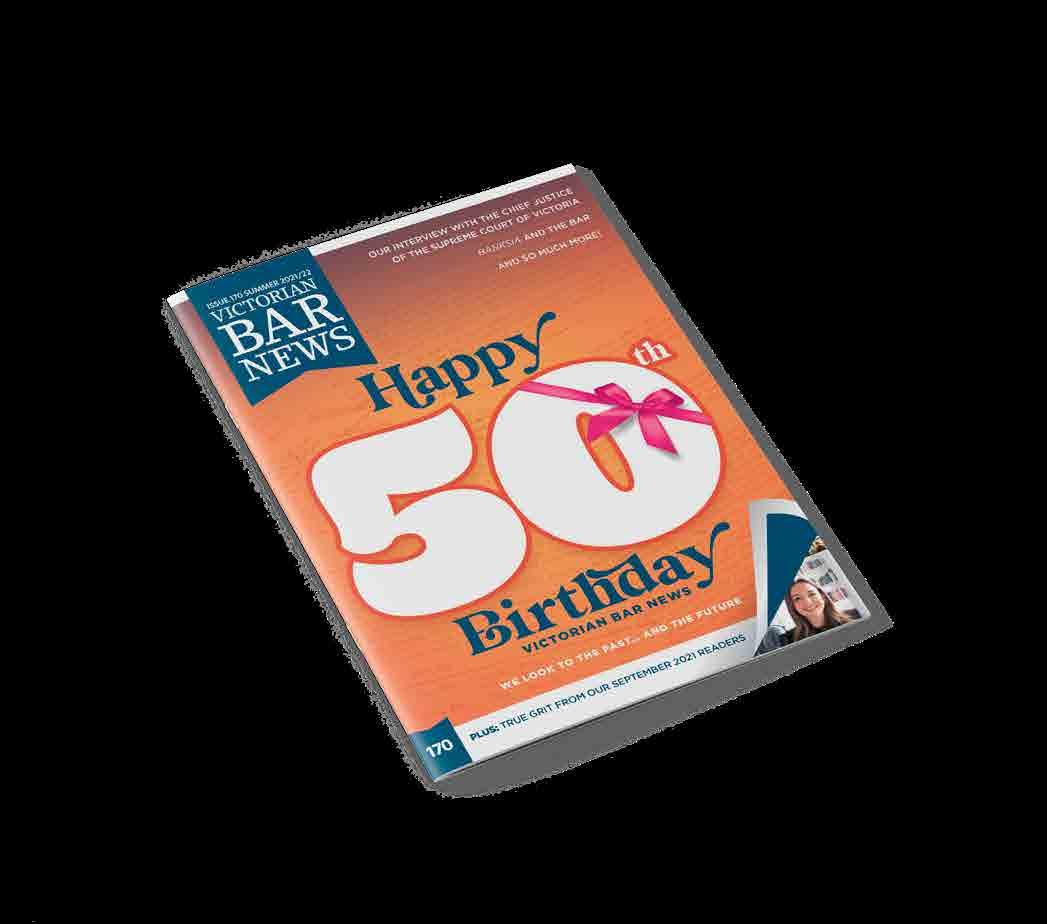
The Bar News Committee is assisted by copy editor Peter Barrett, and Guy Shield who deals with layout, illustrations, design and typesetting. Southern Impact was responsible for final production of the summer and winter issue. The Committee is grateful also to Denise Bennett and Joseph McGregor for their invaluable administrative support.
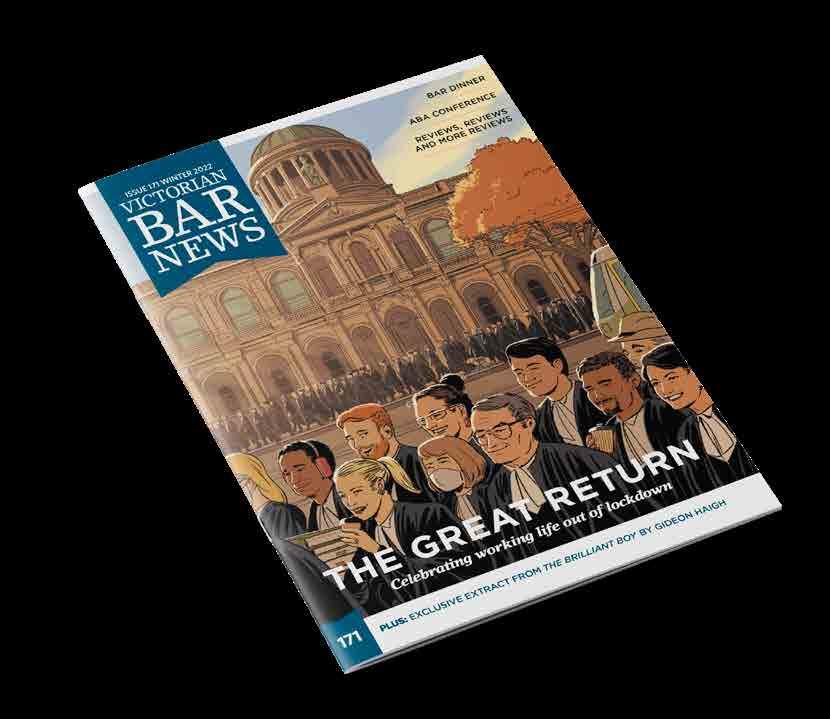

The Bar congratulates members appointed to Public, Judicial and other Office:
Federal Court of Australia
The Honourable Justice Lisa Hespe
The Honourable Justice Timothy McEvoy
Federal Circuit and Family Court of Australia
Her Honour Judge Caroline Jenkins Division 2 (Adelaide Registry)
The Honourable Justice Andrew Strum Division 1 (Melbourne Registry)
Her Honour Judge Anna Parker Division 2 (Adelaide Registry)
The Honourable Justice Alister McNab Division 1 (Melbourne Registry)
The Honourable Justice Alice Carter Division 1 (Melbourne Registry)
His Honour Judge Paul Glass Division 2 (Melbourne Registry)
Her Honour Judge Alison Burt Division 2 (Melbourne Registry)
Senior Judicial Registrar Ms Celia Conlan (Melbourne Registry)
Senior Judicial Registrar Ms Sharney Jenkinson (Sydney Registry)
Senior Judicial Registrar Mr Paul Glass (Melbourne Registry)
Supreme Court of Victoria
Court of Appeal
The Honourable Justice Cameron Macaulay
Trial Division
The Honourable Justice Dr Catherine Gail Button KC
The Honourable Justice Amanda Claire Fox
The Honourable Justice Andrea Tsalamandris
The Honourable Associate Justice Matthew Barrett
Judicial Registrar Elizabeth Jane Tueno
County Court of Victoria
His Honour Judge Stewart Bayles
Her Honour Judge Kellie Blair
Her Honour Judge Nola Karapanagiotidis
His Honour Judge Daniel Holding
Her Honour Judge Angela Ellis
Her Honour Deputy Chief Judge Meryl Sexton
His Honour Judge Gary Clark
His Honour Judge Andrew Fraatz
His Honour Judge Simon Moglia
Her Honour Judge Maria Tsikaris
His Honour Judge Peter Rozen
Judicial Registrar David Bennett (Commercial Division)
Judicial Registrar Rosalind Avis (Crime Division)
Magistrates’ Court of Victoria
His Honour Magistrate Rohan Lawrence
Her Honour Magistrate Cecily Hollingworth
Her Honour Magistrate Cynthia Lynch
His Honour Magistrate Tim Greenway
Her Honour Magistrate Samantha Poulter
Coroners Court of Victoria
Coroner Catherine Fitzgerald
VCAT
Deputy President Richard Wilson
Judge Advocate General of the Australian Defence Force
Rear Admiral the Honourable Jack Rush RFD KC RAN
Law Aid
(Victorian Bar Incorporated and Law Institute of Victoria)
Paul O’Dwyer SC (Trustee)
James Mighell KC
Michelle Britbart KC
Fiona Ryan SC
Fair Work Commission
Deputy President Mr Andrew M Bell
Medico-Legal Joint Standing Committee
Tim Tobin SC
Mary Anne Hartley KC
Marietta Bylhouwer
Dr Paul Halley
Police/Lawyers Liaison Joint Standing Committee
Ian Hill KC
Australian Bar Association
Board of Directors
Dr Matthew Collins AM KC (President) and Róisín Annesley KC (Victorian Bar Representative) Committees
Criminal Law Committee
Zoe Broughton, Zubin Menon, Amelia Beech, Paul Smallwood, and Ffyona Livingstone Clark
Diversity & Inclusion Committee
Christopher McDermott
Ethics Committee
Dr Michael Rush KC, Patrick Doyle, Maree Norton and Maya Narayan
Family Law Committee
Tim Puckey KC and Andrew Barbayannis
First Nations Committee
Thomas Keely SC and Anne Sheehan
International Committee
Lord Chief Justice Michael Whitten, Paul Hayes KC, Stewart Maiden KC and Raini Zambelli
Taxation Committee
Jennifer Batrouney AM KC, Daniel McInerney KC, Angela Lee, Gareth Redenbach and Michael Wells
Law Council of Australia
Directors
Lachlan Molesworth
Committees and Working Groups
Advisory Committee
Simon Molesworth AO KC, Paul Holdenson KC, His Honour David
Parsons SC, Dr David Neal SC, Peter Willis SC, Jenny Firkin KC,
Michael Stanton, Emrys Nekvapil, Shanta Martin and Alan Ford
Legal
Practice Section - Committees
Jennifer Batrouney AM KC
Business Law Section – Committees
George Golvan KC, David Shavin KC, Jennifer Batrouney AM KC, Philip Crutchfield KC, Frank O’Loughlin KC, Renee Enbom KC, Carl Moller, Dr Elizabeth Boros and Angela Lee.
Family Law Section – Executive Committee
Dr Robin Smith
Federal Litigation Section – Committees
Paul Willee RFD KC, David Shavin KC, Tony Nolan KC, Rachel Doyle KC, Michael Gronow KC, Frank O’Loughlin KC, Georgina
Costello KC, Stephen Moloney, Jonathan Kirkwood and Min Guo.
Access to Justice Committee
David Neal SC (Co-chair)
Business and Human Rights Committee
Shanta Martin
Charities and NFP Law Committee
Jennifer Batrouney AM KC
Equal Opportunity Committee
Jenny Firkin KC
Futures Committee
Laurence White
Indigenous Legal Issues Committee
Julie Buxton
National Criminal Law Committee
David Neal SC (Co-chair), Paul Holdenson KC and Michael Stanton
National Human Rights Committee
Emrys Nekvapil
Rural Regional and Remote Committee
Simon Molesworth AO KC
young Lawyers Committee
Alan Ford
Defamation Working Group
Renee Enbom KC
Corporate Governance Committee
Claire Harris KC
Modernising Document Executive Working Group
David Neal SC
Investment Committee
Lachlan Molesworth
National Security Law Committee
Ian Upjohn CSC KC
Commonwealth Courts and Tribunals
Federal Court of Australia
Corporations and Commercial NPA user Group
Stewart Maiden KC, Anthony Strahan KC, Michael Borsky
KC, Cam Truong KC, Dr Oren Bigos KC, Greg Ahern, Alison Umbers and Raini Zambelli.
Employment & Industrial Relations NPA user Group
Malcolm Harding SC
State Courts and Tribunals
Supreme Court of Victoria
Rules Committee
Jonathon Moore KC
Law Library of Victoria Committee
Dr Paul Vout KC and Lucy Line
Chief Justice’s Legal Costs Committee
Stewart Maiden KC
Insolvency (Bankruptcy and Corporate Insolvency) user Group
Philip Corbett KC, Michael Gronow KC, Carl Moller and Charles Parkinson
Intellectual Property users’ Group
David Shavin KC and Tom Cordiner KC
Supreme Court Library Committee
Dr Paul Vout KC and Lucy Line
Probate users’ Committee
Richard Boaden, Shane Newton, Simon Pitt, Ursula Stanisich, Thomas Mah and Eleanor Coates
County Court of Victoria
County Court Rules Committee
Georgina Coghlan KC and Michael Corrigan
Commercial Division users Group
Jeremy Twigg KC, Con Salpigtidis, Andrew Downie and Georgia Berlic
Magistrates’ Court of Victoria
Alternative Dispute Resolution Committee
Carey Nichol, Steven Lowry and Nussen Ainsworth
Criminal user Group
David Hallowes SC, Jason Gullaci and Alexander Patton
Family Property Division user Group
Carolyn Sparke KC, Richard Boaden, Robert Shepherd, Graham Robertson, Carol McOmish, Ursula Stanisich, John Hall and Nathan McOmish
Civil Practice Committee
Hugh Burchill and Steven Lowry
Criminal Court user Group
Colin Mandy SC, Andrew Sim and Amanda Burnnard
Statutory Appointments
Legal Services Board
Jennifer Batrouney AM KC (Advocate elected member)
Legal Services Council – Admissions Committee
The Honourable Justice Arthur Emmett AO (Chair) and The Honourable David Habersberger KC
Representatives on Educational Bodies
Melbourne Law School Advisory Council
Jennifer Batrouney AM KC
Melbourne Law School Tax Masters Advisory Committee
Terry Murphy KC (Chair), Jennifer Batrouney AM KC, Frank O’Loughlin KC and Mia Clarebrough
Legal Services Council – Law Admissions Consultative Committee (LACC)
The Honourable David Habersberger KC
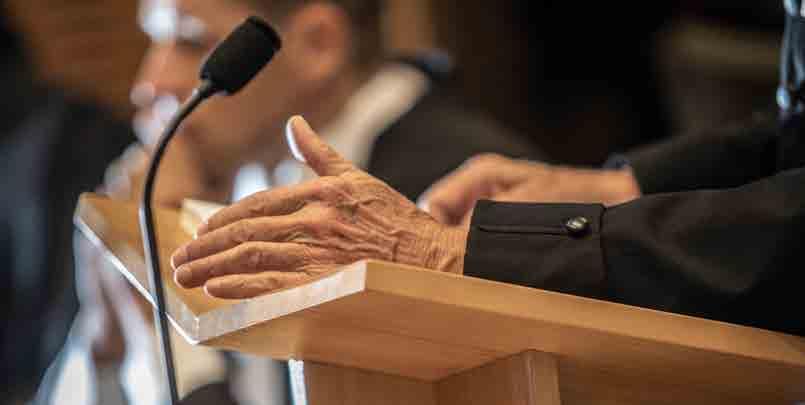
International Bar Association - Diversity and Inclusion Council
Fiona McLeod AO SC
Law Aid – Trustees
James Mighell KC and Fiona Ryan SC
Other Bodies
ACICA Board
Jonathan Redwood SC (Vice President), Caroline Kenny KC, Andrew Hanak KC, Malcolm Holmes KC and Mark Dempsey SC
ATO Public Advice and Guidance Panel
Jennifer Batrouney AM KC
Australian Bar Review - Editorial Board
Annette Charak
Charity Law Association of Australia & New Zealand
Jennifer Batrouney AM KC
Competition & Consumer Law
Daniel Clough, Alice Muhlebach and Tim Farhall
Commonwealth Lawyers Association
Fiona McLeod AO SC
Victoria university College of Law & Justice Program
Advisory Committee
Dr David Denton RFD KC
Monash university Centre for Commercial Law and Regulatory Studies - CLARS External Advisory board
The Honourable Raymond Finkelstein AO KC, Dr Oren Bigos KC, Dr Warwick Rothnie and Ian Horak
Council of Law Reporting
Michael Pearce SC and Annette Charak
Disability Discrimination Commissioner
Dr Ben Gauntlett
Fair Work Commission Termination of Employment
user Group
Yasser Bakri and Rebecca Preston
Firearms Appeals Committee
Katherine Brazenor (Chairperson), Paul Stefanovic and Samuel Stafford
Heritage Council of Victoria
The Honourable Simon Molesworth AO KC and Adrian Finanzio SC
International Bar Association – Bar Issues Committee
Fiona McLeod AO SC
Law Institute of Victoria – Commercial Law
Section Committee
Jennifer Batrouney AM KC, Christopher Furnell, Tim Grace, John Morgan, Dr Philip Bender, Emma Mealy, Andrew Sykes, Matthew Meng, Khai-Yin Lim, Sanjay Schrapel and Amanda Storey.
Law Institute of Victoria – Charities and Not-For-Profit Committee
Jennifer Batrouney AM KC and Dr Philip Bender
Law Institute of Victoria – States Taxes Committee
Tim Grace
Law Institute of Victoria – Tax and Revenue Committee
John Morgan and Matthew Meng
Law Institute of Victoria - IP and IT Committee
Khai-Yin Lim and Sanjay Schrapel
Legal Practitioners Liability Committee Board
Adrian Finanzio SC
Legal Super Pty Ltd
James Peters AM KC
Mediator Standards Board - Board of Directors
Dr Peter Condliffe
Post Sentence Authority
Michele Williams KC (Chair)
Standing Exam Review Panel (SERP)
The Honourable Justice Matthew Connock
Takeovers Panel
Michael Borsky KC
Victorian Assisted Reproductive Treatment Authority (VARTA) – Board member
Nicole Mollard
Victoria Legal Aid - Collaborative Planning Committee
Gordon Chisholm
Victoria Law Foundation Board
Peter Caillard
Victorian Law Reform Commission
Kathleen Foley
Victorian Legal Admissions Board
The Honourable David Habersberger KC (Chair), Lachlan Molesworth and Alexandra Golding
Victorian Legal Admissions Committee
The Honourable David Habersberger KC (Chair), Ian Waller
KC, Matthew Harvey KC, Sam Hay KC, Lisa Hannon KC, Alexandra Golding, Tamieka Spencer Bruce, Dr Magda Karagiannakis and Gerard Butcher RFD
Victorian Legal Admissions Academic Course
Appraisal Committee
The Honourable David Habersberger KC (Chair), Dr Jason Harkess and Dr Magda Karagiannakis.

The Bar Council records with deep regret the death of the following members and past members of the Victorian Bar:
2021/22
His Honour Frank D Saccardo QC, BR No: 1738, 16 September 2021
David Millward Clarke, BR No: 1898, 13 October 2021
His Honour Anthony P Duckett OBE, BR No: 710, 22 October 2021
The Honourable Sir James A Gobbo AC QC, BR No: 568, 7 November 2021
His Honour Graham L Fricke QC, BR No: 652, 7 November 2021
The Honourable Geoffrey M Giudice AO, BR No: 1942, 17 November 2021
Jeremy St John QC, BR No: 1831, 20 December 2021
The Honourable Dr Raymond Moyle Northrop QC, BR No: 474, 31 December 2021
David B Blackburn RFD, BR No: 590, 6 January 2022
Christopher Dane QC, BR No: 1057, 7 January 2022
Ronald I Gipp, BR No: 3164, 24 January 2022
Gregory M McDermott, BR No: 1651, 4 February 2022
John H Greenwell, BR No: 521, 22 February 2022
Gerald A Lewis QC, BR No: 955, 26 February 2022
Beverley Marea Hooper, BR No: 999, 8 March 2022
Charles William George Wheeler, BR No: 724, 9 April 2022
Giuseppe John Sala, BR No: 1967, 20 April 2022
The Honourable Peter Vickery QC, BR No: 1382, 25 April 2022
Angela Cranenburgh, BR No: 3576, 10 May 2022
Sir Francis Gerard Brennan AC KBE, 1 June 2022
Dr Lynne Foreman, BR No: 2902, 3 June 2022
Douglas Raymond Meagher ED QC, BR No: 725, 5 June 2022
Judge Paul Mullaly QC, BR No: 483, 14 June 2022
Nicholas Hanos, BR No: 2291, 23 June 2022
During the year, the following Victorian judges, members and past members of the Victorian Bar were recipients of the following honours:
Australia Day Honours 2022
The Honourable G Tony Pagone AM KC
The Queen’s Birthday Honours 2022
The Honourable Chief Justice Edvard William Alstergren AO
Rear Admiral the Honourable John (Jack) T Rush AO FRD KC RAN
The Honourable Justice John Eric Middleton AM
45 years at the Bar
The Honourable Stuart R Morris KC
Noel Magee KC
Charles Gunst KC
Patrick Tehan OAM KC
Gregory Davies KC
Maxwell Perry
Lindsay Paine
Damian Austin
Russell Young
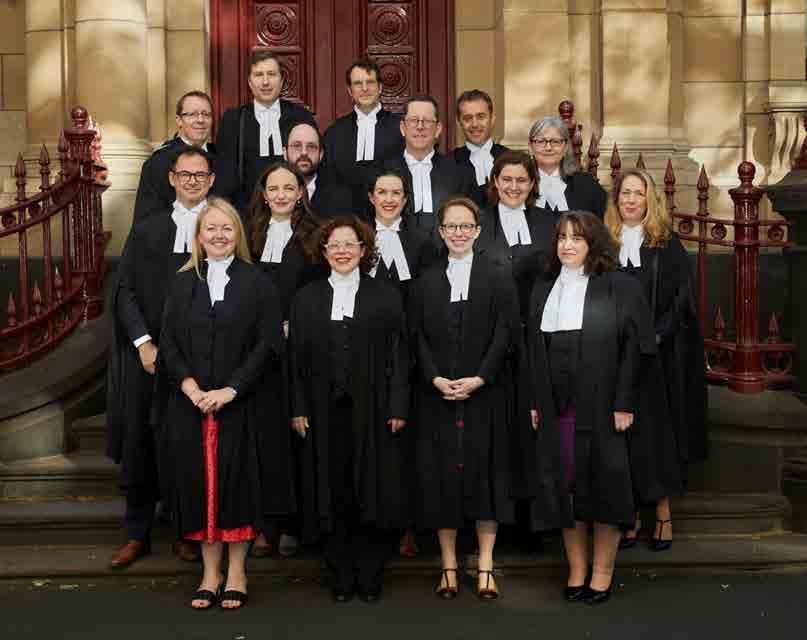
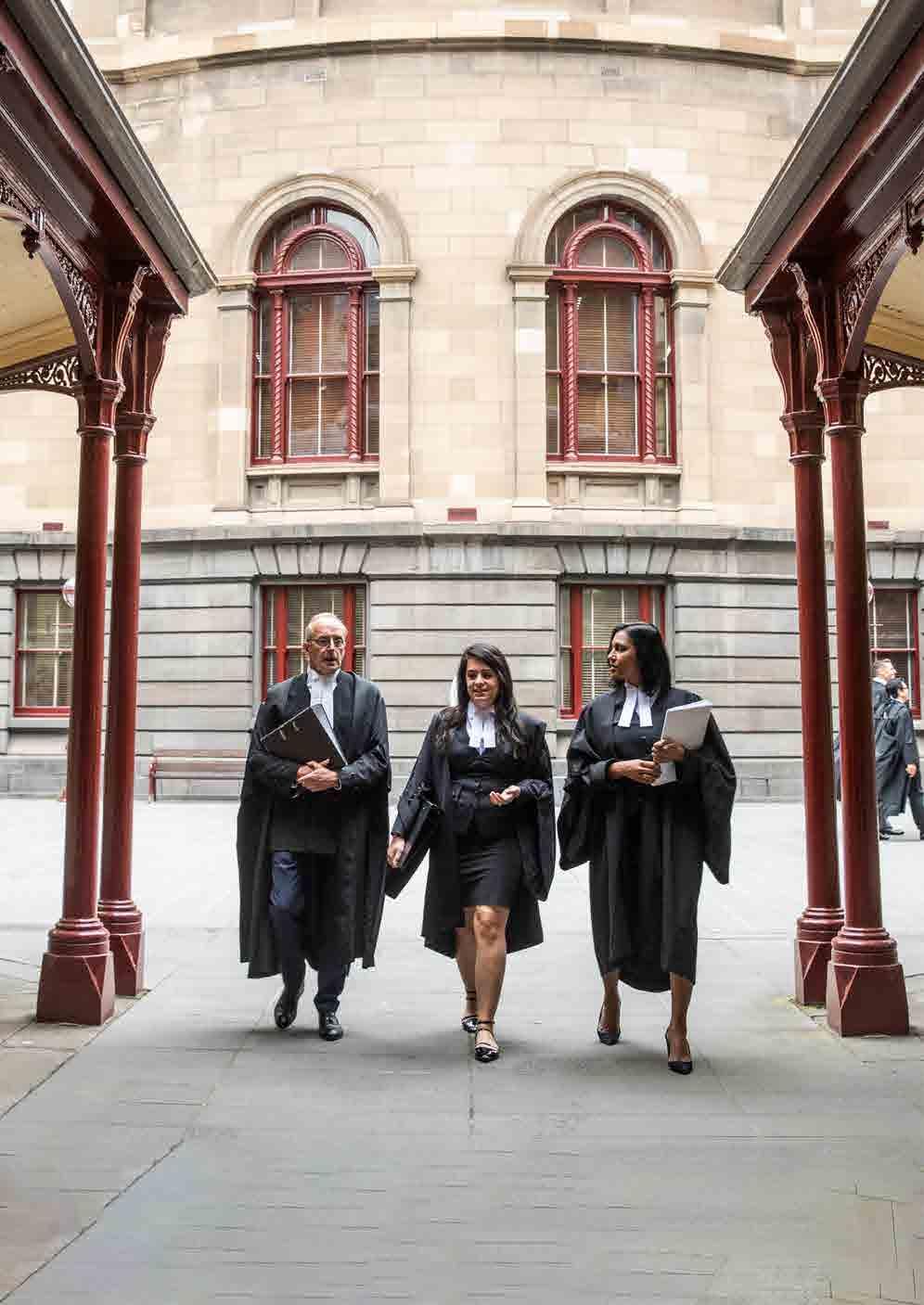
The following is a statistical profile of membership of the Bar Association and a listing of those joining, leaving or transferring their membership during the year ended 30 June 2022.
The following persons signed, re-signed, transferred or were removed from the Roll of Counsel:
Division A Part I (Victorian Practising Counsel)
Signed Christopher Hooper, Matthew James Stalmeisters O’Grady, Christopher P O’Donnell, Annette Gaber, Cheryl Richardson, Rebecca Aoukar, Justin Tevelein, Amrita Malik, Jade Ryan, Andrew Blunt, Rebecca Ayres, Adriel Tsang, Michael Thomas, Winnie Wong, Matthew Garozzo, Rhiannon Saint, Nussen Ainsworth, Bryn Overend, Kate Ottrey, Sai Ranjit, David Barton, Alyse Mobrici, Joseph Acutt, Hamish McAvaney, Patrick Santamaria, Nicholas Dodds, Ashlea Patterson, Olivia Callahan, Hannah Douglas, Liliana Dubroja, Michael Wyles, Erin Byrt, Katharine Brown, Jack Maxwell, Madeleine Salinger, Luisa Frederico, Pranaven Pathmaraj, Leo Seward, Sergio Zanotti Stagliorio, Pinar Tat, Natasha Freijah, Christopher Brydon, Elizabeth Brumby, Paris Lettau, Daniel Dober, Stephen Bunce, Julian Lynch, John O’Halloran, Amara Hughes, Nicole Tyson, Alissa Crittenden, Michelle Button, Jessica Mackay, Tamir Katz, Catherine Pase, Benedict Coxon, Gabriel Chipkin, Laila Hamzi, Mark Gioskos, Kylie McInnes, Jessica Hotchkin, Hannah Canham, Hugh Crosthwaite, Katrina Hartman, Simon Bobko, Celeste Shambrook, Dean Merriman, Andrew Hanna, Rohan
Phelps, Alice Wharldall, Thomas Rawlinson, Sepideh Sadri, Anthony Middleton, Brandan Cooper, Alexis Buckley, Jakub Patela, Gisela Nip, Vincent Vuu, Greer Boe, Tomas Acutt, Harriet Geddes, Yusur Al-Azzawi, Hannah Hofmann, Samuel Cooper, Kenny Cheng, James Gray, Angus Willoughby, Joshua Sheppard, Eugene Twomey, Catherine Jones Williams, D’Arcy Hope, Joshua Bridgett, John Petras, Mark James, Laurence Fudim, Angelika Yianoulatos, Andrew McNaught
Re-signed Amy Peek, Mary Sevdalis, Cameron R Gauld, Eric D Wawra, Joseph D Theseira
Transfers from Timothy J Seccull KC, Brian E Walters AM KC, Albert F Skerlj, Denis R Gibson, Andrew M J Larkin, John Munro, Vicki L Marty, Richard Antill, Christopher V Doidge, Julian Ireland, Helen M Rofe KC, Catherine G Button, Jonathan D Forbes, Catherine L Symons, Richard B C Wilson, Stewart Bayles, Kellie Blair, Daniel P Holding, Nola Karapanagiotidis, Roona Nida, Susan M K Borg, Ashleigh M Harrold, Gary B Hevey, Celia M Conlan,
Sharney Jenkinson, Rohan H Lawrence, Cynthia Lynch, Rosalind Avis, David W Bennett, Elizabeth J Tueno, Sonari M Fernando, Caroline J Jenkins, Andrew I Strum, Dimitrios Podaridis, Heather Gordon, Tim Greenway, Samantha J Poulter, Andrew L Purcell, Andrew M Bell, Peter J Jopling AM KC, Stephen G O’Bryan KC, Gary Clark, Wendy Duncan, Andrew J Fraatz, Simon A Moglia, Maria Tsikaris, Estelle A Frawley, Lisa Hespe SC, Malcolm Strang, Michael J Sharpley, Christine M Haag, Michael C Garner, Jim Buchecker, Alison J Burt, Anthony Elder, Catherine E M Fitzgerald, Nicholas Green KC, Clive W Rosen, Peter C Rozen KC, Graham W Robertson, Warren S Mosley, Christopher J Wren KC, Stephen G Blewett, R Howard Friedman, John B Nunns, Matthew P Barrett, Stephanie Clancy,
John P Constable, Harlis Kirimof, Daniel Porceddu, Dean A Ross, Jane Warren, Keith Wolahan MP, Geoffrey M Gibson
Transfers to Anna M Bogan, His Honour Ronald D Curtain, James P Fitzgerald, J Damian Ellwood, William A D Edwards, Zubin Menon, the Honourable Jennifer Davies, Sonari M Fernando, the Honourable Paul Anastassiou KC
Removed from Charles Scerri KC, Kristy M Fisher, Monika A Furman, Julian P Siggins, Cameron R Gauld, Sarah E Bruhn, Gerard O’Shea, Andy Naidu, Anthony M Beck-Codoy, Bill Baarini, Harry Bleas, Amel Masinovic
Division A Part II (Crown Prosecutors & Public Defenders)
Signed Scott Collins
Transfers from Angela S Ellis, James P Fitzgerald, Cecily B Hollingworth, Zubin Menon
Transfers to Stephanie Clancy, Daniel Porceddu, Jane Warren
Remain in Erin E Ramsay (appointed Crown Prosecutor)
Name removed Nic Chow
Division A Part III (Interstate and Overseas Counsel)
Signed
Rebecca Ann McEwen, Kathryn Gail Davenport KC, Muneebuddin Mohammed, Andrew Boe
Transfers from Raymond C Smith, Vincent Ruta, Robert A Cameron, William A D Edwards, Henry H Jackson
Transfers to Richard Antill, Estelle A Frawley
Removed from Prue M Bindon, Grant R Allan, Robert R Stitt KC, Noelle Hurley, Timothy J Hancock
Division A Part IV (Vic Practising Counsel temporarily absent without current PC)
Transfers from Anna M Bogan, Sonari M Fernando
Transfers to Roona Nida, Sonari M Fernando, Dimitrios Podaridis, Heather Gordon, Malcolm Strang, Harlis Kirimof
Division B (Judiciary and Official Appointments)
Transferred To
Helen M Rofe KC (appointed to the Federal Court of Australia)
Raymond C Smith (appointment as Arbitrator for Workcover Western Australia)
Catherine G Button (appointed to the Supreme Court of Victoria)
Jonathan D Forbes (appointed to the Federal Circuit Court of Australia)*
Catherine L Symons (appointed to the Federal Circuit Court of Australia)*
Stayed In Patmalar Ambikapathy, Nick J Button
Removed from Nic Chow, Eric D Wawra
Richard B C Wilson (appointed as Deputy President of the Victorian Civil and Administrative Tribunal)
Stewart Bayles (appointed to the County Court of Victoria)
Kellie Blair (appointed to the County Court of Victoria)
Angela S Ellis (appointed to the County Court of Victoria)
Daniel P Holding (appointed to the County Court of Victoria)
Nola Karapanagiotidis (appointed to the County Court of Victoria)
The Honourable Geoffrey A A Nettle AC KC (appointed as a Special Investigator for the Royal Commission into the Management of Police Informants (RCMPI))
Nicholas Papas KC (appointed as Acting Director of Public Prosecutions - Northern Territory)
Susan M K Borg (appointed as Deputy Chief Counsel within the office of the RCMPI Special Investigation Group, led by the Hon Geoffrey A A Nettle AC KC)
Ashleigh M Harrold (appointed as Deputy Chief Counsel within the office of the RCMPI Special Investigation Group, led by the Hon Geoffrey A A Nettle AC KC)
Gary B Hevey (appointed as Deputy Chief Counsel within the office of the RCMPI Special Investigation Group, led by the Hon Geoffrey A A Nettle AC KC)
Celia M Conlan (appointed as Senior Judicial Registrar of the Federal Circuit and Family Court of Australia - Melbourne Registry)
Sharney Jenkinson (appointed as Senior Judicial Registrar of the Federal Circuit and Family Court of Australia – Sydney Registry)
Cecily B Hollingworth (appointed to the Magistrates’ Court of Victoria)
Rohan H Lawrence (appointed to the Magistrates’ Court of Victoria)
Cynthia Lynch (appointed to the Magistrates’ Court of Victoria)
Rosalind Avis (appointed as Judicial Registrar of the County Court of Victoria)
David W Bennett (appointed as Judicial Registrar of the County Court of Victoria)
Elizabeth J Tueno (appointed as Judicial Registrar of the Supreme Court of Victoria)
Caroline J Jenkins (appointed to the Federal Circuit and Family Court of Australia – Division 2, Adelaide Registry)
Andrew I Strum (appointed to the Federal Circuit and Family Court of Australia - Division 1, Melbourne Registry)
Tim Greenway (appointed to the Melbourne Magistrates’ Court of Victoria)
Samantha J Poulter (appointed to the Melbourne Magistrates’ Court of Victoria)
Andrew L Purcell (appointment as Examiner at the Australian Criminal Intelligence Commission)
Andrew M Bell (appointed as Deputy President at Fair Work Commission)
Stephen G O’Bryan KC (appointed as Special Manager for the Melbourne Casino Operator)
Henry H Jackson (appointed as President of the State Administrative Tribunal – District Court of Western Australia)
Gary Clark (appointed to the County Court of Victoria)
Andrew J Fraatz (appointed to the County Court of Victoria)
Simon A Moglia (appointed to the County Court of Victoria)
Maria Tsikaris (appointed to the County Court of Victoria)
Lisa Hespe SC (appointed to the Federal Court of Australia)
The Honourable Paul A Coghlan AO KC (appointed as Special Adviser at the Office of the Special Investigator for the Royal Commission into the Management of Police Informants (RCMPI))
Rebecca J Leshinsky (appointed to the Victorian Civil and Administrative Tribunal as a Non-Sessional Member)
Alison J Burt (appointed to the Federal Circuit and Family Court of Australia - Division 2, Melbourne registry)
Catherine E M Fitzgerald (appointed to the Coroners Court of Victoria)
Peter C Rozen KC (appointed to the County Court of Victoria)
Paul S Glass (appointed as Senior Judicial Registrar of the Federal Circuit and Family Court of Australia – Division 1, Melbourne registry)
Matthew P Barrett (appointed as Associate Judge of the Supreme Court of Victoria)
Keith Wolahan MP (appointed as a federal MP)
*Appointment dated 27 July 2021. The Federal Circuit Court amalgamated with the Family Court of Australia on 1 September 2021.
The Honourable Justice Cameron C Macaulay (appointed as Judge of Appeal of the Supreme Court of Victoria)
Senior Registrar Dr Anna Parker (appointed to the Federal Circuit and Family Court of Australia – Division 2, Adelaide Registry)
Her Honour Judge Amanda C Fox (appointed to the Supreme Court of Victoria)
His Honour Judge Philip G Misso (appointed as Reserve Judge of the County Court of Victoria)
Her Honour Judge Meryl E Sexton (appointed as Deputy Chief Judge of the County Court of Victoria)
The Honourable Justice Timothy J F McEvoy (appointed to the Federal Court of Australia)
His Honour Judge David G Brookes (appointed as Reserve Judge of the County Court of Victoria)
Her Honour Judge Alice E Carter (appointed to the Federal Circuit and Family Court of Australia – Division 1, Melbourne registry)
His Honour Judge Alister McNab (appointed to the Federal Circuit and Family Court of Australia – Division 1, Melbourne registry)
Transfers from
The Honourable Justice John Champion, Kevin J Andrews MP, the Honourable Sir Anthony H M Evans, His Honour Judge Chris O’Neill, the Honourable Associate Justice Rodney Randall, the Honourable Justice Kim W S Hargrave, the Honourable Justice Kirsty A Macmillan, the Honourable Justice Paul E Anastassiou, the Honourable Justice Jennifer Davies, the Honourable Justice Ross Robson, the Honourable Justice Chris M Maxwell AC, His Honour
Judge Phillip J Coish, the Honourable Justice John Digby, His Honour Judge Mark E Dean, His Honour Graham Anderson , His Honour
Mark P Taft2, His Honour Christopher J Ryan3 Her Honour Frances Millane4 His Honour Howard T Mason5 His Honour John A Jordan6
Re-signed Owen Mahoney
Division C (Retired)
His Honour Ronald D Curtain, the Honourable Geoffrey A A Nettle AC KC, J Damian Ellwood, the Honourable Paul Anastassiou KC, the Honourable Paul A Coghlan AO KC
Transfers to Timothy J Seccull KC, Albert F Skerlj, Brian E Walters AM KC, Denis R Gibson, Andrew M J Larkin, John Munro, Vicki L Marty, Christopher V Doidge, Julian Ireland, Vincent Ruta, the Honourable Justice John Champion, Robert A Cameron, Kevin J Andrews MP, the Honourable Sir Anthony H M Evans, Peter J Jopling AM KC, Wendy Duncan, His Honour Judge Chris O’Neill, The Honourable Associate Justice Rodney Randall, the Honourable Justice Kim W
Division D
Transfers from Rebecca J Leshinsky
Grant of PC
Anna M Bogan, Christopher Hooper, Matthew James Stalmeisters O’Grady, Amy Peek, His Honour Ronald D Curtain, James P Fitzgerald, Christopher P O’Donnell, J Damian Ellwood, Annette Gaber, Cheryl Richardson, Rebecca Aoukar, Justin Tevelein, Amrita Malik, Jade Ryan, Andrew Blunt, Rebecca Ayres, Adriel Tsang, Michael Thomas, Winnie Wong, Matthew Garozzo, Rhiannon Saint, Nussen Ainsworth, Bryn Overend, Kate Ottrey, Sai Ranjit, David Barton, Alyse Mobrici, Joseph Acutt, Hamish McAvaney, Patrick Santamaria, Nicholas Dodds, Ashlea Patterson, Olivia Callahan, Hannah Douglas, Liliana Dubroja, Michael Wyles, Erin Byrt, Katharine Brown, Jack Maxwell, Madeleine Salinger, Luisa Frederico, Pranaven Pathmaraj, Leo Seward, Sergio Zanotti Stagliorio, Pinar Tat, Natasha Freijah, Christopher Brydon, Elizabeth Brumby, Paris Lettau, Daniel Dober, Stephen Bunce, Julian Lynch, John O’Halloran,
S Hargrave, the Honourable Justice Kirsty A Macmillan, Michael J Sharpley, the Honourable Justice Paul E Anastassiou, Christine M Haag, Michael C Garner, Jim Buchecker, Anthony Elder, Nicholas Green KC, Clive W Rosen, the Honourable Justice Ross Robson, Graham W Robertson, the Honourable Justice Chris M Maxwell AC, Warren S Mosley, Christopher J Wren KC, Stephen G Blewett, His Honour Judge Phillip J Coish, R Howard Friedman, John B Nunns, the Honourable Justice John Digby, John P Constable, His Honour Judge Mark E Dean, Dean A Ross, Geoffrey M Gibson, His Honour Graham Anderson , His Honour Mark P Taft2 His Honour Christopher J Ryan3, Her Honour Frances Millane4 His Honour Howard T Mason5, His Honour John A Jordan6
Amara Hughes, Mary Sevdalis, His Honour Ronald D Curtain, James P Fitzgerald, J Damian Ellwood, William A D Edwards, Cameron R Gauld, Eric D Wawra, Joseph D Theseira, Zubin Menon, The Honourable Jennifer Davies, Sonari M Fernando, Nicole Tyson, Alissa Crittenden, Michelle Button, Jessica Mackay, Tamir Katz, Catherine Pase, Benedict Coxon, Gabriel Chipkin, Laila Hamzi, Mark Gioskos, Kylie McInnes, Jessica Hotchkin, Hannah Canham, Hugh Crosthwaite, Katrina Hartman, Simon Bobko, Celeste Shambrook, Dean Merriman, Andrew Hanna, Rohan Phelps, Alice Wharldall, Thomas Rawlinson, Sepideh Sadri, Anthony Middleton, Brandan Cooper, Alexis Buckley, Jakub Patela, Gisela Nip, Vincent Vuu, Greer Boe, Tomas Acutt, Harriet Geddes, Yusur Al-Azzawi, Hannah Hofmann, Samuel Cooper, Kenny Cheng, James Gray, Angus Willoughby, Joshua Sheppard, Eugene Twomey, Catherine Jones Williams, D’Arcy Hope, Joshua Bridgett, John Petras, Mark James, Laurence Fudim, Angelika Yianoulatos, Andrew McNaught, The Honourable Paul Anastassiou KC, Scott Collins
Registered No. A0034304S
Owen Dixon Chambers East
Level 5 / 205 William Street
Melbourne, Victoria 3000
T: 03 9225 7111
E: vicbar@vicbar.com.au
W: www.vicbar.com.au
Bar Council Members
Ms Róisín Annesley KC (President)
Mr Charles E Shaw KC (Vice-President)
Mr Darryl Burnett (Vice-President)
Mr Mark A Robins KC (Honorary Treasurer)
Ms Robyn Sweet (Assistant Honorary Treasurer)
Mr Peter A Chadwick KC
Mr Robert Hay KC
Mr Paul Hayes KC
Ms Marylyn Smallwood SC
Mr Sam D Hay KC
Dr Michelle Sharpe
Ms Maria Pilipasidis
Mr Benjamin J Murphy
Ms Amy L Wood
Dr Robin Smith
Ms Nawaar Hassan
Mr Daniel Nguyen
Ms Raini Zambelli
Mr Nicholas Phillpott
Ms Lana Collaris
Ms Andrèa Skinner
Ms Sarah Cherry (Honorary Secretary)
Mr Eitan Makowski (Assistant Honorary Secretary)
Mr Owen Wolahan (Assistant Honorary Secretary)
ACN 004 454 004
Board of Directors
The Honourable John Digby KC (Chairman) – (appointed September 2021)
Mr Adrian Finanzio SC (Acting Chairman - ceased Dec 2021)
Mr Sam Hay KC (Deputy Chairman)
Mr Frank Parry KC – (appointed December 2021)
Ms Susan Brennan SC – (ceased August 2021)
Ms Penny Neskovcin KC – (ceased December 2021)
Mr Eugene Wheelahan KC
Mr Romauld Andrew – (appointed December 2021)
Mr Benjamin Murphy – (appointed September 2021)
Mr Paul Clark (CEO and Managing Director)
Ms Catherine Walter AM
Mr Mick Brennan
ACN 624 652 357
Board of Directors
Ms Susan Brennan SC (ceased 27 August 2021), Mr Paul Clark
ACN 004 640 108
Ms Róisín Annesley KC
Mr Mark A Robins KC
X
The officers, members of the Council of the Victorian Bar Incorporated, submit herewith the annual financial report of the Association for the financial year ended 30 June 2022. In order to comply with the provisions of the Associations Incorporation Reform Act 2012 and generally appropriate good practice disclosure, the Officers report as follows:
The names of the Officers of the Association during or since the end of the financial year are included on page 9 of the annual report under Bar Council.
The Victorian Bar Incorporated is a professional association for lawyers practising solely as barristers. As well as serving its barrister members, the Bar serves the public interest through its activities in improving access to justice and law reform and its pro bono work. The Bar has two wholly owned subsidiary companies: Barristers Chambers Limited owns and leases buildings, which are provided as chambers to barristers, and provides telephone and internet services to members of the Bar; and The Melbourne Bar
Pty Ltd which is a non-operating nominee company. Barristers Chambers Limited has one wholly owned subsidiary, Opus Workspaces Pty Ltd, which provides serviced office space.
During the financial year ended 30 June 2022 the Association achieved a surplus from continuing operations of $642,548 (2021: $1,041,577) and an income tax benefit of $18,708 (2021: $694 expense). Its consolidated surplus from continuing operations was $14,139,945(2021: $900,819) and an income tax expense of $1,099,334 (2021: $694,110 benefit).
Except as set out in the accompanying financial reports, there was no significant change in the state of affairs of the Association during the financial year.
The outbreak of COVID-19 and the subsequent quarantine measures imposed, have continued to impact on the organisation during the year. Post 30 June 2022, although COVID-19 is still with us, it is less of an impact.
The impact of the COVID-19 pandemic is still ongoing, and the group will continue to adjust to the varying conditions. The Officers of the Association consider that the potential financial effects of COVID-19 on the Association’s financial statements cannot be reasonably estimated for future financial periods.
There has been no other matter or circumstance which has arisen since the end of the year that has significantly affected, or may significantly affect the company’s operations, the result of those operations or the company’s state of affairs.
Substantial changes in the operations of the Association are ordinarily determined by a vote of members which are communicated other than through the Annual Report.
The Association is not subject to any significant environmental regulations under Australian law.
The Association is incorporated under the Associations Incorporation Act 1981 (Vic). It is precluded under the Act and its Constitution from paying a dividend to its members. The Association is a not for profit organisation.
During the financial year, the Association paid a premium in respect of a contract insuring the Officers of the Association (as named above and on page 9 of the Annual Report) and all Executive Officers of the Association and of any related body corporate against a liability incurred as an officer or executive officer to the extent permitted by the Association’s Constitution.
The contract of insurance prohibits disclosure of the nature of the liability and the amount of the premium.
The Association has not otherwise, during or since the financial year, except to the extent permitted by law, indemnified or agreed to indemnify an officer or auditor of the Association or of any related body corporate against a liability incurred as such an officer or auditor.
Proceedings on Behalf of the Association
No person has applied for leave of court to bring proceedings on behalf of the Association or to intervene in any proceedings to which the Association is a party for the purpose of taking responsibility on behalf of the Association for all or part of those proceedings.
Associations Incorporation Reform Act 2012
Sections 94(2)(b), 97(2)(b) and 100(2)(b)
Annual Statements Give True and Fair View of Financial Position of Incorporated Association
We, Róisín Annesley KC and Mark Robins KC, being President and Honorary Treasurer of the Victorian Bar Council respectively, and members of the Victorian Bar Council, which is the Committee of the Victorian Bar Incorporated certify that:
The financial statements (and notes thereto) attached to this certificate give a true and fair view of the financial position of the Victorian Bar Incorporated during and at the end of the financial year of the Association ended on 30 June 2022.
Dated this 24th day of October 2022.
Signed in accordance with a resolution of the Council made pursuant to the Constitution of the Victorian Bar. On behalf of the Officers.

Róisín Annesley KC President 24 October 2022
Mark Robins Honorary
Treasurer
24 October 2022

Opinion
We have audited the financial report of The Victorian Bar Incorporated and its subsidiaries (the “Group”), which comprises the consolidated statement of financial position as at 30 June 2022, the consolidated statement of profit or loss and other comprehensive income, consolidated statement of changes in equity and consolidated statement of cash flows for the year then ended, and notes to the financial statements, including a summary of significant accounting policies and declaration by the Officers as set out on pages 57 to 77.
In our opinion, the accompanying financial report presents fairly, in all material respects, the Group’s financial position as at 30 June 2022, and of its financial performance and its cash flows for the year then ended, in accordance with Australian Accounting Standards to the extent described in Note 3 to the financial report, the Associations Incorporation Reform Act 2012 and the Constitution.
We conducted our audit in accordance with Australian Auditing Standards. Our responsibilities under those standards are further described in the Auditor’s Responsibilities for the Audit of the Financial Report section of our report. We are independent of the Group in accordance with the ethical requirements of the Accounting Professional and Ethical Standards Board’s APES 110 Code of Ethics for Professional Accountants (including Independence Standards) (the Code) that are relevant to our audit of the financial report in Australia. We have also fulfilled our other ethical responsibilities in accordance with the Code.
We believe that the audit evidence we have obtained is sufficient and appropriate to provide a basis for our opinion.
We draw attention to Note 3 to the financial report, which describes the basis of accounting. The financial report has been prepared for the purpose of fulfilling the Officers financial reporting responsibilities under the Associations Incorporation Reform Act 2012 and the Constitution. As a result, the financial report may not be suitable for another purpose. Our report is intended solely for the members and should not be distributed or used by parties other than the members. Our opinion is not modified in respect of this matter.
The Officers are responsible for the other information. The other information comprises the information included in, or distributed with the annual financial report, but does not include the financial report and our auditor’s report thereon.
Our opinion on the financial report does not cover the other information and we do not express any form of assurance conclusion thereon.
In connection with our audit of the financial report, our responsibility is to read the other information and, in doing so, consider whether the other information is materially inconsistent with the financial report or our knowledge obtained in the audit or otherwise appears to be materially misstated. If, based on the work we have performed, we conclude that there is a material misstatement of this other information, we are required to report that fact. We have nothing to report in this regard.
The Officers are responsible for the preparation and fair presentation of the financial report in accordance with Australian Accounting Standards and the Associations Incorporation Reform Act 2012 and the Constitution and for such internal control as the Officers determine is necessary to enable the preparation and fair presentation of the financial report and is free from material misstatement, whether due to fraud or error.
In preparing the financial report, the Officers are responsible for assessing the Group’s ability to continue as a going concern, disclosing, as applicable, matters related to going concern and using the going concern basis of accounting unless the Officers either intend to liquidate the Group or to cease operations, or have no realistic alternative but to do so.
Our objectives are to obtain reasonable assurance about whether the financial report as a whole is free from material misstatement, whether due to fraud or error, and to issue an auditor’s report that includes our opinion. Reasonable
assurance is a high level of assurance but is not a guarantee that an audit conducted in accordance with the Australian Auditing Standards will always detect a material misstatement when it exists. Misstatements can arise from fraud or error and are considered material if, individually or in the aggregate, they could reasonably be expected to influence the economic decisions of users taken on the basis of this financial report.
As part of an audit in accordance with the Australian Auditing Standards, we exercise professional judgement and maintain professional scepticism throughout the audit. We also:
› Identify and assess the risks of material misstatement of the financial report, whether due to fraud or error, design and perform audit procedures responsive to those risks, and obtain audit evidence that is sufficient and appropriate to provide a basis for our opinion. The risk of not detecting a material misstatement resulting from fraud is higher than for one resulting from error, as fraud may involve collusion, forgery, intentional omissions, misrepresentations, or the override of internal control.
› Obtain an understanding of internal control relevant to the audit in order to design audit procedures that are appropriate in the circumstances, but not for the purpose of expressing an opinion on the effectiveness of the Group’s internal control.
› Evaluate the appropriateness of accounting policies used and the reasonableness of accounting estimates and related disclosures made by the Officers.
› Conclude on the appropriateness of the Officers’ use of the going concern basis of accounting and, based on the audit evidence obtained, whether a material uncertainty exists related to events or conditions that may cast significant doubt on the Group’s ability to continue as a going concern. If we conclude that a material uncertainty exists, we are required to draw attention in our auditor’s report to the related disclosures in the financial report or, if such disclosures are inadequate, to modify our opinion. Our conclusions are based on the audit evidence obtained up to the date of our auditor’s report. However, future events or conditions may cause the Group to cease to continue as a going concern.
› Evaluate the overall presentation, structure and content of the financial report, including the disclosures, and whether the financial report represents the underlying transactions and events in a manner that achieves fair presentation. We communicate with the Officers regarding, among other matters, the planned scope and timing of the audit and significant audit findings, including any significant deficiencies in internal control that we identify during our audit.


Robert Collie Partner Chartered Accountants
Melbourne, 11 October 2022
The Officers have determined that the Victorian Bar Inc (the “Association”) is not a reporting entity because in the opinion of the Officers there are unlikely to exist users of the financial report who are unable to command the preparation of reports tailored so as to satisfy specifically all of their information needs. Accordingly, this special purpose financial report has been prepared to satisfy the Officers’ reporting requirements under the Victorian Bar Inc.’s Constitution and the Associations Incorporation Reform Act 2012.
The Officers of the Association declare that:
1. The financial statements and notes thereto, as set out on pages 58 to 77:
a. Comply with accounting standards, the Associations Incorporation Reform Act 2012 and the reporting requirements under the Victorian Bar’s Constitution; and
b. Give a true and fair view of the financial position as at 30 June 2022 and performance for the year ended on that date, in accordance with the accounting policies described in Note 3 to the financial statements, of the Association and the Group entities.
2. In the Officers’ opinion there are reasonable grounds to believe that the Association will be able to pay its debts as and when they become due and payable.
Signed in accordance with a resolution of the Council of the Association.
On behalf of the Officers

Róisín Annesley KC President Melbourne, 11 October 2022
Mark Robins KC Honorary
Treasurer
Melbourne, 11 October 2022
Statement of profit or loss and other comprehensive income for the year ended 30 June 2022
(1,844,992)
Building management expenses (9,823,617) (8,608,188)
Technology expenses (1,824,610) (1,778,627)
Utilities expense (2,883,445) (2,594,276)
accompanying notes form part of these financial statements. Statement of financial position at 30 June 2022
The accompanying notes form part of
The Victorian Bar Inc. (“the Association”) is incorporated under the Associations Incorporation Reform Act 2012, Victoria and operates in Australia.
The registered office and the principal place of business of the Association is:
Level 5, 205 William Street Melbourne VIC 3000
The Association is a private, voluntary, self-funded, non-profit, professional association of Barristers who practise in Victoria. Its principal activity during the year was to provide regulatory and other services to barristers who practice in Victoria.
2.1 Amendments to Accounting Standards that are mandatorily effective for the current reporting period
The Association has adopted all the new and revised Standards and Interpretations issued by the Australian Accounting Standards Board (the AASB) that are relevant to their operations and effective for an accounting period that begins on or after 1 July 2021. Their adoption has had no material impact on the disclosures and/or amounts reported in these financial statements.
At the date of authorisation of the financial statements, the Group has not applied the following new and revised Australian Accounting Standards, Interpretations and amendments that have been issued but are not yet effective:
AASB 2020-3 Amendments to Australian Accounting Standards – Annual Improvements 2018-2020 and Other Amendments 1 July 2022
AASB 2022-2 Amendments to Australian Accounting Standards – Disclosure of Accounting Policies and Definition of Accounting Estimates 1 July 2023
The potential impact of the revised Standards/Interpretations on the Association’s financial statements has not yet been determined.
Financial reporting framework
The Officers have determined that the Association is not a reporting entity because, in the opinion of the Officers, there are unlikely to exist users of the financial report who are unable to command the preparation of reports tailored to satisfy specifically all of their information needs. Accordingly, this special purpose financial report has been prepared to satisfy the Officer’s reporting requirements under The Victorian Bar Inc.’s Constitution and the Associations Incorporation Reform Act 2012.
For the purpose of preparing the financial statement, the Association is a not for profit entity.
Statement of compliance
Standards/amendment
AASB 2020-1 Amendments to Australian Accounting Standards – Classification of Liabilities as Current or Non-Current and AASB 2020-6 Amendments to Australian Accounting Standards – Classification of Liabilities as Current or Non-current –Deferral of Effective Date.
Effective for annual reporting periods beginning on or after
1 July 2022
The financial report has been prepared in accordance with the Associations Incorporation Reform Act 2012, the Victorian Bar Inc. Constitution, the basis of accounting specified by all Accounting Standards and Interpretations, and the disclosure requirements of Accounting Standards AASB 101 ‘Presentation of Financial Statements’, AASB 107 ‘Statements of Cash Flow’, AASB 108 ‘Accounting Policies’, ‘Changes in Accounting Estimates and Errors’, and ‘AASB 1054 Australian Additional Disclosures’.
The financial report includes the separate financial statements of the Association and the consolidated financial statements of the Group.
Basis of preparation
The financial report has been prepared on the basis of historical cost, except for the revaluation of certain non-current assets and financial instruments. Cost is based on the fair values of the consideration given in exchange for assets. All amounts are presented in Australian dollars, unless otherwise noted.
In the application of the Group’s accounting policies, management is required to make judgments, estimates and assumptions about carrying values of assets and liabilities that are not readily apparent from other sources. The estimates and associated assumptions are based on historical experience and various other factors that are considered relevant. Actual results may differ from these estimates.
The estimates and underlying assumptions are reviewed on an ongoing basis. Revisions to accounting estimates are recognised in the period in which the estimate is revised if the revision affects only that period or in the period of the revision and future periods if the revision affects both current and future periods.
The Group leases various offices that contain a wide range of different terms and conditions. A lease liability has been recognised for the present value of the estimated cash outflows in relation to the Group’s leases in accordance with AASB 16. The accounting policy for the Group’s leases is disclosed in Note 1(h). The measurement of the lease liability includes the following key assumptions:
› Determining the lease term: Many of the Group’s long-term property leases contain options to extend the lease beyond the initial term. At 30 June 2022, where an option to extend is in the lease contract, the Group has concluded that it is not reasonably certain those options will be exercised.
› Discount rate: Lease payments are discounted using an interest rate of 1.65%, being the incremental borrowing rate available to the Group at the time of implementation of AASB 16 for similar assets on a portfolio basis. There is judgement involved in making this determination.
The Group obtains independent valuations for its investment properties on at least a biennial basis or when there is a significant change in market conditions. All three properties owned by the Group were independently valued at 30 June 2022. The fair values of properties are calculated using a combination of market sales comparison and capitalisation rate. The fair value measurement of investment property has been classified as a level 3 fair value as it’s derived from valuation techniques that include inputs that are not based on observable market data (unobservable inputs).The key judgements for each unobservable valuation input are:
› Market sales comparison: Utilises recent sales of comparable properties, adjusted for any differences including the nature, location and lease profile. The market rent applied at 30 June 2022 across the three properties ranged from $419 to $476 psm;
› Capitalisation rate: Capitalises the fully-leased net income for a property into perpetuity at an appropriate capitalisation rate. The fully leased net income is based on market rents, operating costs and future income on vacant space. The capitalisation rate reflects the nature, location and tenancy profile, together with current market evidence and sales, of comparable properties. The capitalisation rates applied at 30 June 2022 across the three properties ranged from 4.50%-5.5%.
The fair value of the properties is sensitive to these assumptions, in particular the market capitalisation rate. If the market capitalisation rate applied in the valuations was adjusted +/25 basis points, the fair value would be $16,800k higher or $15,200k lower than the amount recognised at 30 June 2022.
Given the current uncertainty in the macroeconomic environment, a higher degree of judgement is required in assessing the inputs that determine property valuations. As there have been a number of transactions in the market throughout the current financial year, there is enough market evidence on which management and independent specialist valuers can rely to appropriately assess the fair value of the properties held. However, the fair values are a best estimate and may differ to the actual sales price if the properties were to be sold.
The Group has assessed the impact of COVID-19 on the expected credit loss allowance against trade receivables outstanding at 30 June 2022. Current and expected collection of trade receivables since the start of the COVID-19 pandemic has been reflected in the assessment. The Group’s expected credit loss allowance increased from $2,399k at 30 June 2021 to $3,754k as at 30 June 2022, and reflects amounts that are more than 30 days overdue for which there is no agreed payment arrangement. The Group continues to pursue collection on all debts, however collection of outstanding receivables is inherently uncertain and actual collections may differ from the amount reflected in the expected credit loss allowance at 30 June 2022.
The Group has various “make good” obligations under its long-term property lease contracts. A provision has been recognised for the present value of the estimated expenditure required to fulfil these obligations at the end of the lease terms. The estimated costs are based on recent make good activity performed by the Group and quotes from suppliers. The range applied to each property is between $21 and $466 per square metre and varies based on the extent of the works required and the standard of the building. Since the works on the various properties will be performed well into the future and can be subject to negotiated outcomes with landlords, the actual cost to make good the properties could differ from the provision recognised as at 30 June 2022.
3. Significant accounting policies (continued)
At 30 June 2022, the Group had $7,031k of right-of-use assets in relation to office floorspace leases held by subsidiary Opus Workspaces Pty Ltd. These floors, in the Melbourne CBD, are currently not used for barristers’ chambers, but rather for nonbarrister office rental. A trigger for impairment was deemed to exist in relation to these assets based on current occupancy levels and negative returns.
The Group has determined that, based on proposed plans to convert the relevant floors to barristers’ chambers, those leased floors can generate profits and an overall return to the Group and concluded the assets were not impaired.
(a)
The consolidated financial statements incorporate the financial statements of the Association and entities controlled by the Association (its subsidiaries) made up to 30 June each year.
Control is achieved when the Association:
› has the power over the investee;
› is exposed, or has rights, to variable returns from its involvement with the investee; and has the ability to use its power to affects its returns.
The Association reassesses whether it controls an investee if facts and circumstances indicate that there are changes to one or more of the three elements of control listed above.
Consolidation of a subsidiary begins when the Association obtains control over the subsidiary and ceases when the Association loses control of the subsidiary. Specifically, the results of subsidiaries acquired or disposed of during the year are included in profit or loss from the date the Association gains control until the date when the Association ceases to control the subsidiary.
Where necessary, adjustments are made to the financial statements of subsidiaries to bring the accounting policies used into line with the Group’s accounting policies.
All intragroup assets and liabilities, equity, income, expenses and cash flows relating to transactions between the members of the Group are eliminated on consolidation.
(b)
Cash comprises cash on hand and on demand deposits. Cash equivalents are short-term, liquid investments that are readily convertible to known amounts of cash and which are subject to an insignificant risk of changes in value. Bank overdrafts are shown within borrowings in current liabilities in the statement of financial position.
A liability is recognised for benefits accruing to employees in respect of wages and salaries, annual leave and long service leave when it is probable that settlement will be required, and they are capable of being measured reliably.
Liabilities recognised in respect of employee benefits expected to be settled within 12 months are measured at their nominal values using the remuneration rate expected to apply at the time of settlement.
Liabilities recognised in respect of employee benefits which are not expected to be settled within 12 months are measured as the present value of the estimated future cash outflows to be made by the Group in respect of services provided by employees up to the reporting date.
Subscription income received by the Association from its members is non-taxable through the mutuality principle. Receipts from non-members are regarded as assessable income for income tax purposes. Member expenses are non-deductible. Other expenses which are not directly deductible from assessable income are apportioned between non-tax deductible and tax-deductible expenses according to taxation regulations.
All income received by Barristers Chambers Limited, a subsidiary association of the Association, and its subsidiary (Opus Workspaces Pty Ltd), is taxable.
The charge for current income tax expenses is based on the profit for the year adjusted for any non-assessable or disallowed items. It is calculated using tax rates that have been enacted or are substantively enacted by the balance sheet date.
Deferred tax is accounted for using the balance sheet liability method in respect of temporary differences arising between the tax bases of assets and liabilities and their carrying amounts in the financial statements. No deferred income tax will be recognised from the initial recognition of an asset or liability, excluding a business combination, where there is no effect on accounting or taxable profit or loss.
Deferred tax is calculated at the tax rates that are expected to apply to the period when the asset is realised, or liability is settled. Deferred tax is credited in the income statement except where it relates to items credited or debited directly to equity, in which case the deferred tax is adjusted directly against equity.
Deferred income tax assets are recognised to the extent that it is probable that future tax profits will be available against which deductible temporary differences or unused tax losses and tax offsets can be utilised.
The amount of benefits brought to account or which may be realised in the future is based on the assumption that no adverse change will occur in income taxation legislation and
3. Significant accounting policies (continued)
(d) Income Tax (continued)
the anticipation that the economic entity will derive sufficient future assessable income to enable the benefit to be realised and comply with the conditions of deductibility imposed by the law.
The Association and its subsidiaries, Barristers’ Chambers Ltd and The Melbourne Bar Pty Ltd, together with Opus Workspaces Pty Ltd, are part of a tax-consolidated Group under Australian taxation law. The Association is the head entity in the tax-consolidated Group. Tax expense/income, deferred tax assets and deferred tax liabilities arising from temporary differences of the members of the tax-consolidated Group are recognised using the ‘Group allocation’ approach by reference to the carrying amounts in the separate financial statements of each entity and the tax values applying under tax consolidation. Current tax liabilities and assets and deferred tax assets arising from unused tax losses and relevant tax credits of the members of the tax-consolidated Group are recognised by the Association (as head entity in the tax-consolidation Group).
Plant and equipment, leasehold improvements and equipment under finance lease are stated at cost less accumulated depreciation and impairment. Cost includes expenditure that is directly attributable to the acquisition of the item. In the event that settlement of all or part of the purchase consideration is deferred, cost is determined by discounting the amounts payable in the future to their present value as at the date of acquisition.
The carrying amount of plant and equipment is reviewed annually by the Association’s Officers to ensure it is not in excess of the recoverable amount from these assets. The recoverable amount is assessed on the basis of the expected net cash.
The depreciable amount of all property, plant and equipment including buildings and capitalised leased assets, but excluding freehold land, is depreciated on a straight-line basis over their useful lives to the economic entity commencing from the time the asset is held ready for use. Leasehold improvements are depreciated over the shorter of either the unexpired period of the lease or the estimated useful lives of the improvements.
Depreciation Rate
Leasehold Improvements 4-10%
Plant and Equipment 5-33%
The assets’ residual values and useful lives are reviewed, and adjusted if appropriate, at each reporting period. An asset’s carrying amount is written down immediately to its recoverable amount if the asset’s carrying amount is greater than its estimated recoverable amount. Gains and losses on disposals are determined by comparing proceeds with the carrying amount.
These gains and losses are included in the income statement. When revalued assets are sold, amounts included in the revaluation reserve relating to that asset are transferred to retained earnings.
Investment properties, being land and office buildings, are held for rental yields and are not occupied by the Group. They are carried at fair value. Changes in fair values are presented in profit and loss as part of other income. The cost of major renovations and improvements are capitalised as an addition. The cost of maintenance, repairs and minor improvements are charged to profit and loss when incurred.
The Group obtains independent valuations for its investment properties at least every two years. At the end of each reporting period, the Officers update their assessment of the fair value of each property, taking into account the most recent independent valuations. The Group determine a property’s value within a range of reasonable fair value estimates.
The best evidence of fair value is current prices in an active market for similar properties. Where such information is not available the officers consider information from a variety of sources including:
› current prices in an active market for properties of different nature or recent prices of similar properties in less active markets, adjusted to reflect those differences;
› discounted cash flow projections based on reliable estimates of future cash flows; and
› capitalised income projections based upon a property’s estimated net market income, and a capitalisation rate derived from an analysis of market evidence.
Intangible assets with finite lives that are acquired separately are carried at cost less accumulated amortisation and accumulated impairment losses. Amortisation is recognised on a straight-line basis over their estimated useful lives. The estimated useful life and amortisation method are reviewed at the end of each reporting period, with the effect of any changes in estimate being accounted for on a prospective basis. Intangible assets with indefinite useful lives that are acquired separately are carried at cost less accumulated impairment losses.
An internally generated intangible asset arising from
3. Significant accounting policies (continued)
(h) Intangible assets (continued)
development (or from the development phase of an internal project) is recognised if, and only if, all of the following have been demonstrated: the technical feasibility of completing the intangible asset so that it will be available for use or sale; the intention to complete the intangible asset and use or sell it; the ability to use or sell the intangible asset; how the intangible asset will generate probable future economic benefits; the availability of adequate technical, financial and other resources to complete the development and to use or sell the intangible asset; and the ability to measure reliably the expenditure attributable to the intangible asset during its development.
The amount initially recognised for internally generated intangible assets is the sum of the expenditure incurred from the date when the intangible asset first meets the recognition criteria listed above. Where no internally generated intangible asset can be recognised, development expenditure is recognised in profit or loss in the period in which it is incurred. Subsequent to initial recognition, internally generated intangible assets are reported at cost less accumulated amortisation and accumulated impairment losses, on the same basis as intangible assets that are acquired separately.
The Group assesses whether a contract is or contains a lease, at inception of the contract. The Group recognises a right-ofuse asset and a corresponding lease liability with respect to all lease arrangements in which it is the lessee, except for shortterm leases (defined as leases with a lease term of 12 months or less) and leases of low value assets (such as small items of office equipment). For these leases, the Group recognises the lease payments as an operating expense on a straight-line basis over the term of the lease unless another systematic basis is more representative of the time pattern in which economic benefits from the leased assets are consumed.
The lease liability is initially measured at the present value of the lease payments that are not paid at the commencement date, discounted by using the rate implicit in the lease. If this rate cannot be readily determined, the Group uses its incremental borrowing rate.
Lease payments included in the measurement of the lease liability comprise:
› Fixed lease payments (including in-substance fixed payments), less any lease incentives receivable
› Variable lease payments that depend on an index or rate, initially measured using the index or rate at the commencement date
› The amount expected to be payable by the lessee under residual value guarantees
The lease liability is presented as a separate line in the statement of financial position.
The lease liability is subsequently measured by increasing the carrying amount to reflect interest on the lease liability (using the effective interest method) and by reducing the carrying amount to reflect the lease payments made.
The right-of-use assets comprise the initial measurement of the corresponding lease liability, lease payments made at or before the commencement day, less any lease incentives received and any initial direct costs. They are subsequently measured at cost less accumulated depreciation and impairment losses.
Right-of-use assets are depreciated over the shorter period of lease term and useful life of the underlying asset. If a lease transfers ownership of the underlying asset or the cost of the right-of-use asset reflects that the Group expects to exercise a purchase option, the related right-of-use asset is depreciated over the useful life of the underlying asset. The depreciation starts at the commencement date of the lease.
The right-of-use assets are presented as a separate line in statement of financial position.
The Group applies AASB 136 Impairment of Assets to determine whether a right-of-use asset is impaired and accounts for any identified impairment loss as described in the ‘Property, plant and equipment’ policy.
Provisions are recognised when the Group has a present obligation (legal or constructive) as a result of a past event, it is probable that the Group will be required to settle the obligation, and a reliable estimate can be made of the amount of the obligation.
The amount recognised as a provision is the best estimate of the consideration required to settle the present obligation at reporting date, taking into account the risks and uncertainties surrounding the obligation. Where a provision is measured using the cashflows estimated to settle the present obligation, it’s carrying amount is the present value of those cashflows.
When some or all of the economic benefits required to settle a provision are expected to be recovered from a third party, the receivable is recognised as an asset if it is virtually certain that reimbursement will be received and the amount of the receivable can be measured reliably.
The Group is required to restore leased premises to their original condition at the end of the respective lease terms.
A provision is recognised for the present value of the estimated expenditure required to remove any leasehold improvements where the obligation and the amount can be reliably estimated.
Trade payables and other accounts payable are recognised when the Group becomes obliged to make future payments resulting from the purchase of goods and services.
Revenue from subscriptions is recognised in the period that the subscription relates to. Revenue from leased properties is recognised on a straight-line basis over the lease term in accordance with lease agreements.
Revenue from the rendering of a service is recognised upon the delivery of the service to the customer by reference to the stage of completion of the service being provided.
Revenue from leased properties is recognised as invoiced on a monthly basis based on the short term tenancy agreements with barristers.
Interest revenue is accrued on a time basis, by reference to the principal outstanding and at the effective interest rate applicable, which is the rate that exactly discounts estimated future cash receipts through the expected life of the financial asset to that asset’s net carrying amount.
All other revenue is stated net of the amount of goods and services tax (GST).
Borrowings are recorded initially at fair value, net of transaction costs. Subsequent to initial recognition, borrowings are measured at amortised cost with any difference between the initial recognised amount and the redemption value being recognised in profit and loss over the period of the borrowing using the effective interest rate method.
Bills of exchange are recorded at an amount equal to the net proceeds received, with the premium or discount amortised over the period until maturity. Interest expense is recognised on an effective yield basis.
Borrowing Costs directly attributable to the acquisition, construction or production of assets that necessarily take a substantial period of time to prepare for their intended use or sale, are added to the cost of those assets, until such time as the assets are substantially ready for their intended use or sale.
All other borrowing costs are recognised in the income statement in the period in which they are incurred.
Revenues, expenses and assets are recognised net of the amount of goods and services tax (GST), except:
i. where the amount of GST incurred is not recoverable from the taxation authority, it is recognised as part of the cost of acquisition of an asset or as part of an item of expense; or ii. for receivables and payables which are recognised inclusive of GST.
The net amount of GST recoverable from, or payable to, the taxation authority is included as part of receivables or payables. Cash flows are included in the cash flow statement on a net basis. The GST component of cash flows arising from investing and financing activities which is recoverable from, or payable to, the taxation authority is classified as operating cash flows.
At each reporting date, the Association reviews the carrying amounts of its tangible and intangible assets to determine whether there is any indication that those assets have suffered an impairment loss. If any such indication exists, the recoverable amount of the asset is estimated in order to determine the extent of the impairment loss (if any). Where the asset does not generate cash flows that are independent from other assets, the Association estimates the recoverable amount of the cash-generating unit to which the asset belongs. Where a reasonable and consistent basis of allocation can be identified, corporate assets are also allocated to individual cash-generating units, or otherwise they are allocated to the smallest Group of cash-generating units for which a reasonable and consistent allocation basis can be identified.
Recoverable amount is the higher of fair value less costs to sell and value in use. In assessing value in use, the estimated future cash flows are discounted to their present value using a pre-tax discount rate that reflects current market assessments of the time value of money and the risks specific to the asset for which the estimates of future cash flows have not been adjusted.
If the recoverable amount of an asset (or cash-generating unit) is estimated to be less than its carrying amount, the carrying amount of the asset (cash-generating unit) is reduced to its recoverable amount. An impairment loss is recognised immediately in profit or loss, unless the relevant asset is carried at revalued amount, in which case the impairment loss is treated as a revaluation decrease.
Where an impairment loss subsequently reverses, the carrying amount of the asset (cash-generating unit) is increased to the revised estimate of its recoverable amount, but only to the extent that the increased carrying amount does not exceed the carrying amount that would have been determined had no impairment loss been recognised for the asset (cashgenerating unit) in prior years. A reversal of an impairment loss is recognised immediately in profit or loss, unless the relevant asset is carried at fair value, in which case the reversal of the impairment loss is treated as a revaluation increase.
Financial assets and financial liabilities are recognised when the Group becomes a party to the contractual provisions of the instrument.
3. Significant accounting policies (continued)
(p) Financial instruments
Financial assets and financial liabilities are initially measured at fair value. Transaction costs that are directly attributable to the acquisition or issue of financial assets and financial liabilities (other than financial assets and financial liabilities at fair value through profit or loss) are added to or deducted from the fair value of the financial assets or financial liabilities, as appropriate, on initial recognition. Transaction costs directly attributable to the acquisition of financial assets or financial liabilities at fair value through profit or loss are recognised immediately in profit or loss.
All regular way purchases or sales of financial assets are recognised and derecognised on a trade date basis. Regular way purchases or sales are purchases or sales of financial assets that require delivery of assets within the time frame established by regulation or convention in the marketplace. All recognised financial assets are measured subsequently in their entirety at either amortised cost or fair value, depending on the classification of the financial asset.
Financial assets that meet the following conditions are measured subsequently at amortised cost:
› the financial asset is held within a business model whose objective is to hold financial assets in order to collect contractual cash flows; and
› the contractual terms of the financial asset give rise on specified dates to cash flows that are solely payments of principal and interest on the principal amount outstanding. By default, all other financial assets are measured subsequently at fair value through profit or loss (FVTPL).
The Association’s financial assets at amortised cost includes trade receivables.
The amortised cost of a financial asset is the amount at which the financial asset is measured at initial recognition minus the principal repayments, plus the cumulative amortisation using the effective interest method of any difference between that initial amount and the maturity amount, adjusted for any loss allowance. The gross carrying amount of a financial asset is the amortised cost of a financial asset before adjusting for any loss allowance.
The effective interest method is a method of calculating the amortised cost of a debt instrument and of allocating interest income over the relevant period.
For financial assets other than purchased or originated credit-impaired financial assets (i.e. assets that are credit-impaired on initial recognition), the effective interest rate is the rate that exactly discounts estimated future cash receipts (including all fees and points paid or received that form an integral part of the effective interest rate, transaction costs and other premiums or discounts) excluding expected credit losses, through the expected life of the debt instrument, or, where appropriate, a shorter period, to the gross carrying amount of the debt instrument on initial recognition. For purchased or originated credit-impaired financial assets, a credit-adjusted effective interest rate is calculated by discounting the estimated future cash flows, including expected credit losses, to the amortised cost of the debt instrument on initial recognition.
The Association recognises a loss allowance for expected credit losses on trade receivables. The amount of expected credit losses is updated at each reporting date to reflect changes in credit risk since initial recognition of the respective financial instrument.
The Association always recognises lifetime expected credit losses (ECL) for trade receivables. The expected credit losses on these financial assets are estimated using a provision matrix based on the association’s historical credit loss experience, adjusted for factors that are specific to the debtors, general economic conditions and an assessment of both the current as well as the forecast direction of conditions at the reporting date, including time value of money where appropriate.
Lifetime ECL represents the expected credit losses that will result from all possible default events over the expected life of a financial instrument.
During 2021, a provision on expected credit losses has been recorded.
The measurement of expected credit losses is a function of the probability of default, loss given default (i.e. the magnitude of the loss if there is a default) and the exposure at default. The assessment of the probability of default and loss given default is based on historical data adjusted by forward-looking information as described above. As for the exposure at default, for financial assets, this is represented by the assets’ gross carrying amount at the reporting date; for financial guarantee contracts, the exposure includes the amount drawn down as at the reporting date, together with any additional amounts expected to be drawn down in the future by default date determined based on historical trend, the entity’s understanding of the specific future financing needs of the debtors, and other relevant forward-looking information.
For financial assets, the expected credit loss is estimated as the difference between all contractual cash flows that are due to
3. Significant accounting policies (continued)
(p) Financial instruments (continued)
the association in accordance with the contract and all the cash flows that the association expects to receive, discounted at the original effective interest rate.
If the Group has measured the loss allowance for a financial instrument at an amount equal to lifetime ECL in the previous reporting period, but determines at the current reporting date that the conditions for lifetime ECL are no longer met, the Group measures the loss allowance at an amount equal to 12-month ECL at the current reporting date, except for assets for which simplified approach was used.
The Association recognises an impairment gain or loss in profit or loss for all financial instruments with a corresponding adjustment to their carrying amount through a loss allowance account.
The Group derecognises a financial asset only when the contractual rights to the cash flows from the asset expire, or when it transfers the financial asset and substantially all the risks and rewards of ownership of the asset to another entity. If the entity neither transfers nor retains substantially all the risks and rewards of ownership and continues to control the transferred asset, the entity recognises its retained interest in the asset and an associated liability for amounts it may have to pay. If the entity retains substantially all the risks and rewards of ownership of a transferred financial asset, the entity continues to recognise the financial asset and also recognises a collateralised borrowing for the proceeds received.
On derecognition of a financial asset measured at amortised cost, the difference between the asset’s carrying amount and the sum of the consideration received and receivable is recognised in profit or loss.
The fair value change on qualifying hedging instruments is recognised in profit or loss except when the hedging instrument hedges an equity instrument designated at fair value through other comprehensive income (“FVTOCI”) in which case it is recognised in other comprehensive income.
The carrying amount of a hedged item not already measured at fair value is adjusted for the fair value change attributable to the hedged risk with a corresponding entry in profit or loss. For debt instruments measured at FVTOCI, the carrying amount is not adjusted as it is already at fair value, but the hedging gain or loss is recognised in profit or loss instead of other comprehensive income. When the hedged item is an equity instrument designated at FVTOCI, the hedging gain or loss remains in other comprehensive income to match that of the hedging instrument.
Where hedging gains or losses are recognised in profit or loss, they are recognised in the same line as the hedged item.
The Group discontinues hedge accounting only when the hedging relationship (or a part thereof) ceases to meet the qualifying criteria (after rebalancing, if applicable). This includes instances when the hedging instrument expires or is sold, terminated or exercised. The discontinuation is accounted for prospectively. The fair value adjustment to the carrying amount of the hedged item arising from the hedged risk is amortised to profit or loss from that date.
Financial liabilities, including borrowings and trade and other payables, are initially measured at fair value, net of transaction costs. All financial liabilities are measured subsequently at amortised cost using the effective interest method.
After initial recognition, interest-bearing loans and borrowings are subsequently measured at amortised cost.
The Group derecognises financial liabilities when, and only when, the Group’s obligations are discharged, cancelled or they expire. The difference between the carrying amount of the financial liability derecognised and the consideration paid and payable is recognised in profit or loss.
Financial assets and financial liabilities are offset and the net amount is reported in the consolidated statement of financial position if there is a currently enforceable legal right to offset the recognised amounts and there is an intention to settle on a net basis, to realise the assets and settle the liabilities simultaneously.
Acquisitions of businesses are accounted for using the acquisition method. The consideration transferred in a business combination is measured at fair value, which is calculated as the sum of the acquisition-date fair values of assets transferred, liabilities incurred and the equity instruments issued by the Association in exchange for control of the acquiree. Acquisitionrelated costs are recognised in profit or loss as incurred. At the acquisition date, the identifiable assets acquired and the liabilities assumed are recognised at their fair values.
Goodwill is measured as the excess of the sum of the consideration transferred over the net of the acquisition-date amounts of the identifiable assets acquired and the liabilities assumed. If, after reassessment, the net of the acquisitiondate amounts of the identifiable assets acquired and liabilities assumed exceeds the sum of the consideration transferred,
the excess is recognised immediately in profit or loss as a bargain purchase gain. Where the consideration transferred by the Association in a business combination includes assets or liabilities resulting from a contingent consideration arrangement, the contingent consideration is measured at its acquisition-date fair value. Changes in the fair value of the contingent consideration that qualify as measurement period adjustments are adjusted retrospectively, with corresponding adjustments against goodwill.
Measurement period adjustments are adjustments that arise from additional information obtained during the ‘measurement period’ (which cannot exceed one year from the acquisition date) about facts and circumstances that existed at the acquisition date.
The subsequent accounting for changes in the fair value of contingent consideration that do not qualify as measurement period adjustments depends on how the contingent consideration is classified. Contingent consideration that is classified as equity is not remeasured at subsequent reporting dates and its subsequent settlement is accounted for within equity. Contingent consideration that is classified as an asset or liability is remeasured at subsequent reporting dates in accordance with AASB 9 ‘Financial Instruments’, or AASB 137 ‘Provisions, Contingent Liabilities and Contingent Assets’, as appropriate, with the corresponding gain or loss being recognised in profit or loss.
If the initial accounting for a business combination is incomplete by the end of the reporting period in which the combination occurs, the Association reports provisional amounts for the items for which the accounting is incomplete. Those provisional amounts are adjusted during the measurement period (see above), or additional assets or liabilities are recognised, to reflect new information obtained about facts and circumstances that existed as of the acquisition date that, if known, would have affected the amounts recognised as of that date.
Goodwill arising on an acquisition of a business is carried at cost as established at the date of the acquisition of the business (see Note q above) less accumulated impairment losses, if any. For the purposes of impairment testing, goodwill is allocated to each of the association’s cash generating units (or Groups of cash-generating units) that is expected to benefit from the synergies of the combination. A cash-generating unit to which goodwill has been allocated is tested for impairment annually,
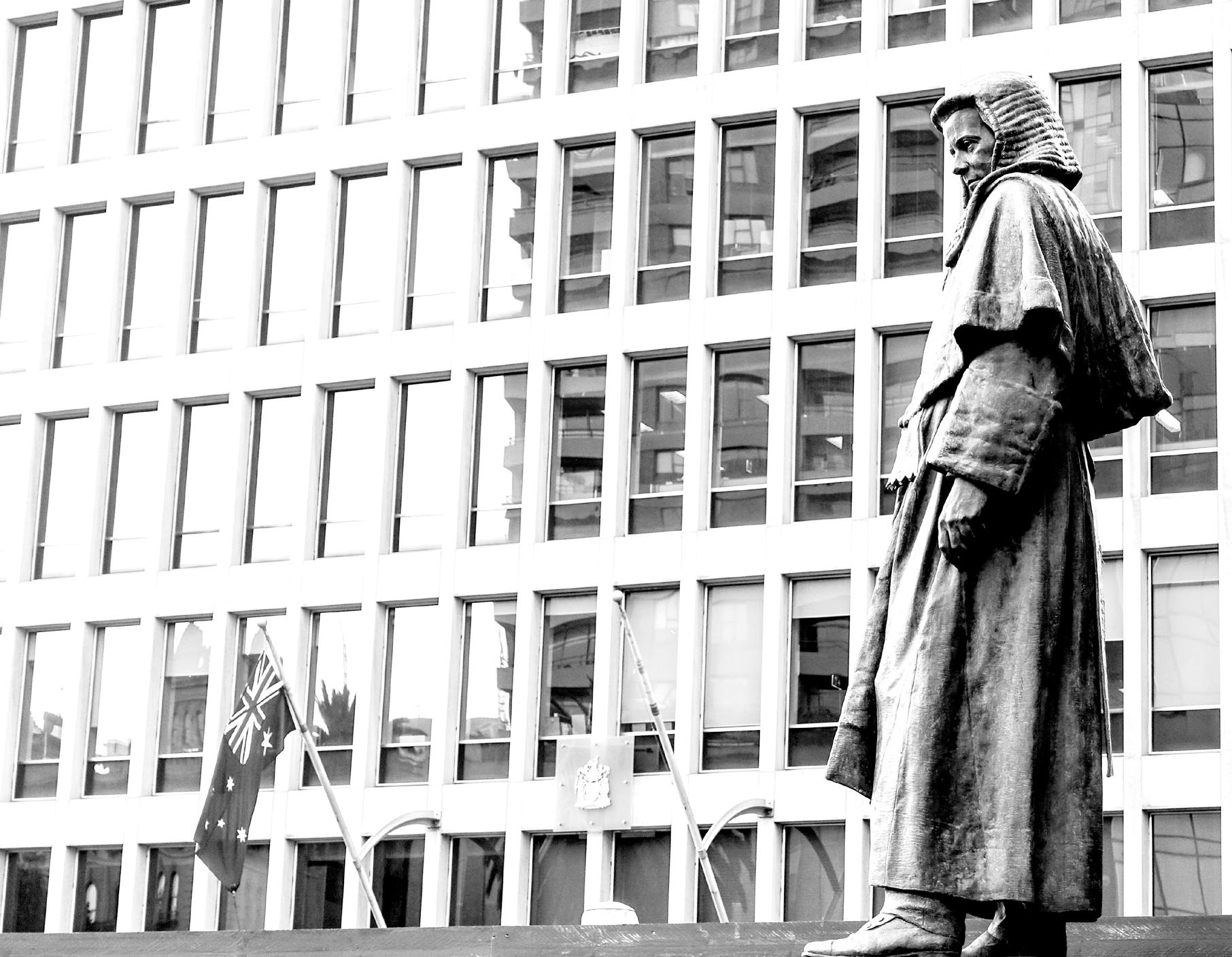
Components of income tax (expense)/benefit Tax expense comprises:
7. Cash and cash equivalents
8. Trade and other receivables
9. Other assets
The useful life of Software used in the calculation of amortisation is 5 years.
(a) Reconciliation of cash and cash equivalents
For the purposes of the statement of cash flows,
16. Borrowings
The loan is secured by a charge over property situated at 525-539 Lonsdale Street, Melbourne known as Owen Dixon Chambers West and property situated at 205-221 William Street, Melbourne known as Owen Dixon Chambers East. The facility matures on 1 May 2023.
Benevolent
Victoria
The Committee of Management for the Association is the Victorian Bar Council through its President and Honorary Treasurer who form the Sub-Committee of Management.
The market value of the Association’s investment portfolio as at 30 June 2022, together with the income yield is set out below:
Comparative Financial Statement for the year Ended 30 June 2022 (unaudited)
During 2021-2022, the Association made payments by way of grants and loans to members and immediate family totalling $130,045 (this also includes loans converted to grants with no further cash payment).
Donations received for the 2021-2022 year were $14,731. In addition, the Association received loan repayments totalling $26,200 during the year.
= Includes imputation
Basis of Preparation of Comparative Financial Statement
The Comparative Financial Statement for the year ended 30 June 2022 has been prepared using historical costs for recording transaction and comparative asset values.
Capital Movement between/within funds
From time to time, capital movements occur between or within the funds managed by Equity Trustees which will be reflected in an adjustment to the closing fund balance.
Róisín Annesley KC and Mark Robins KC Sub-Committee of Management Victorian Bar Council

